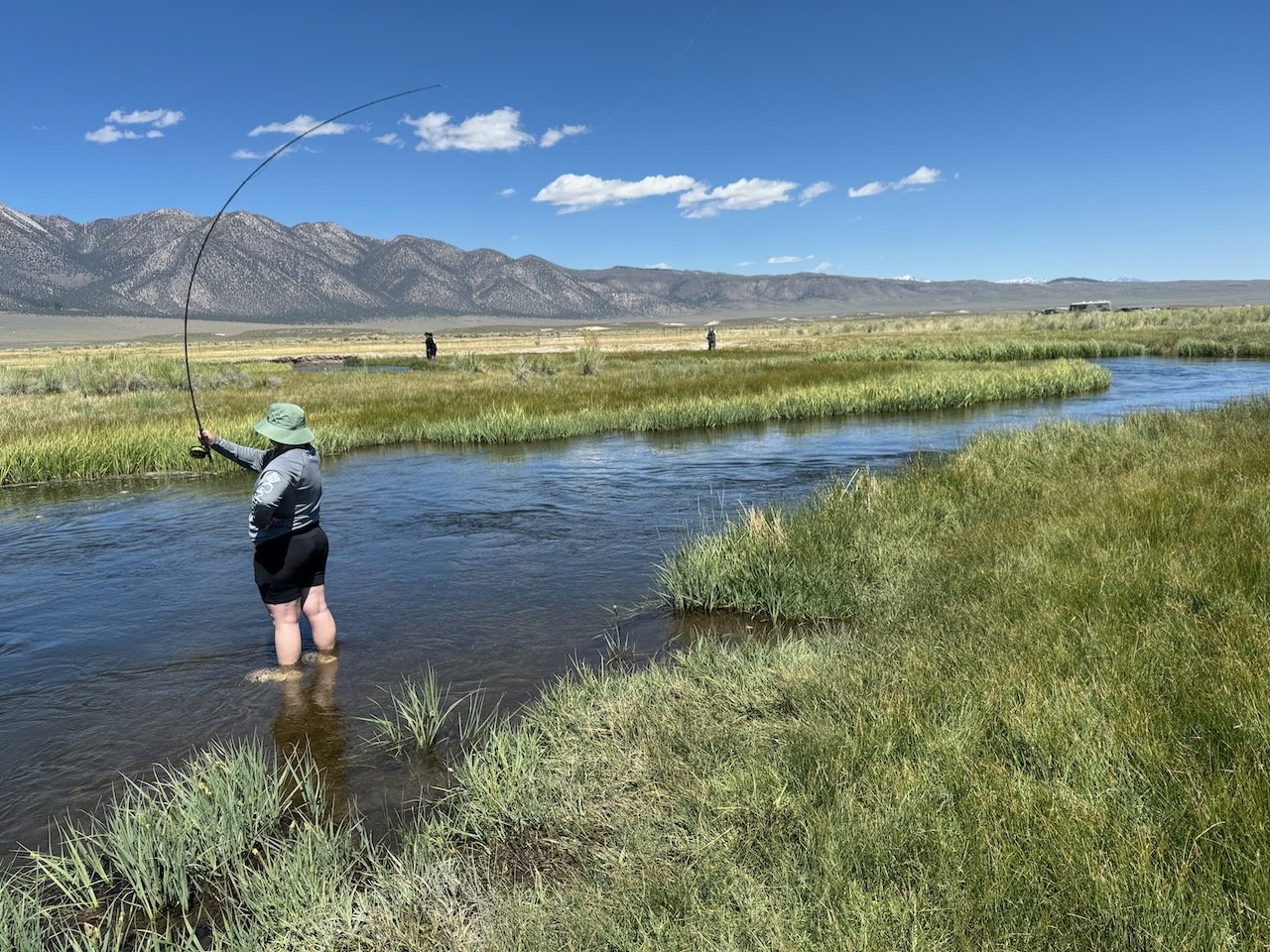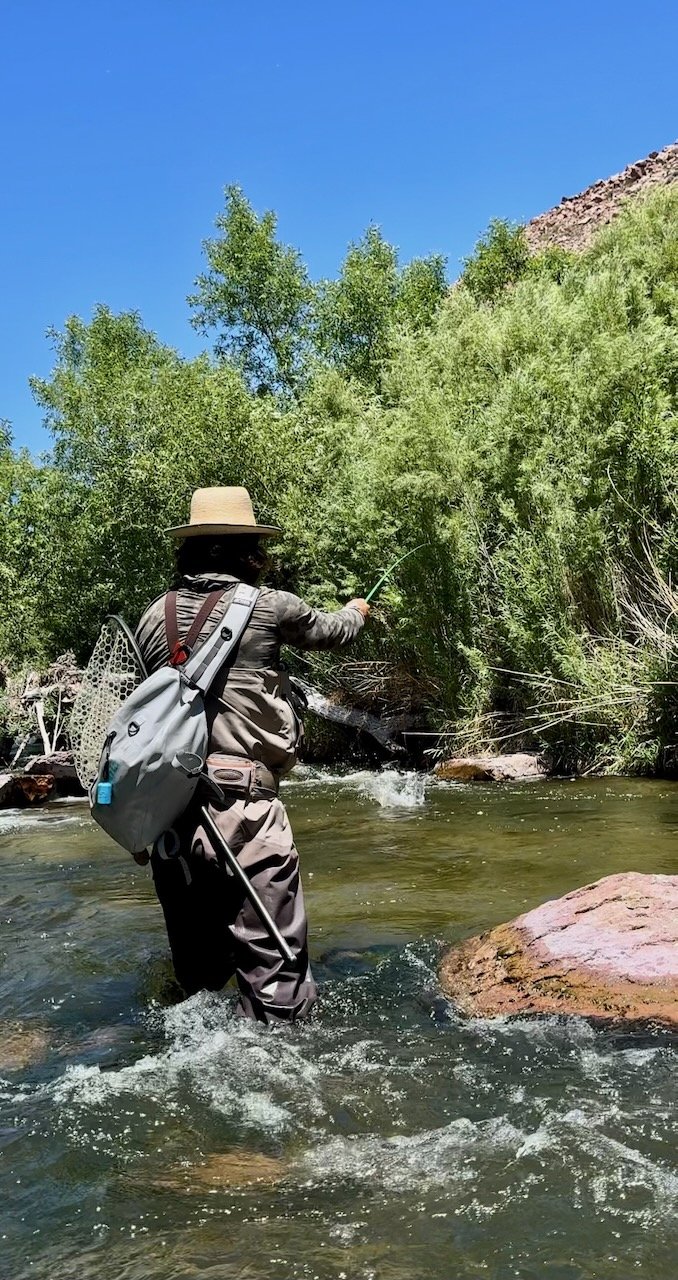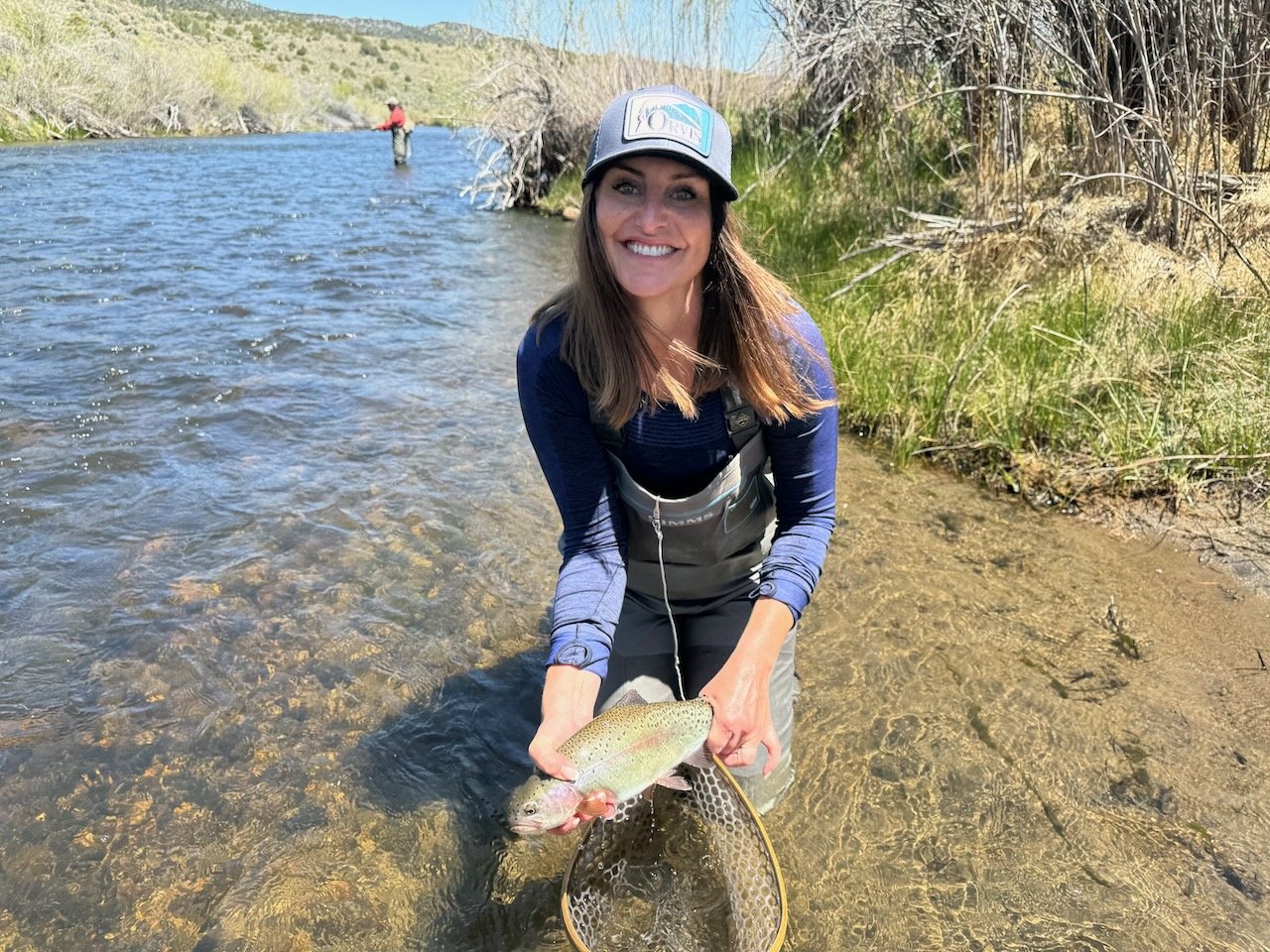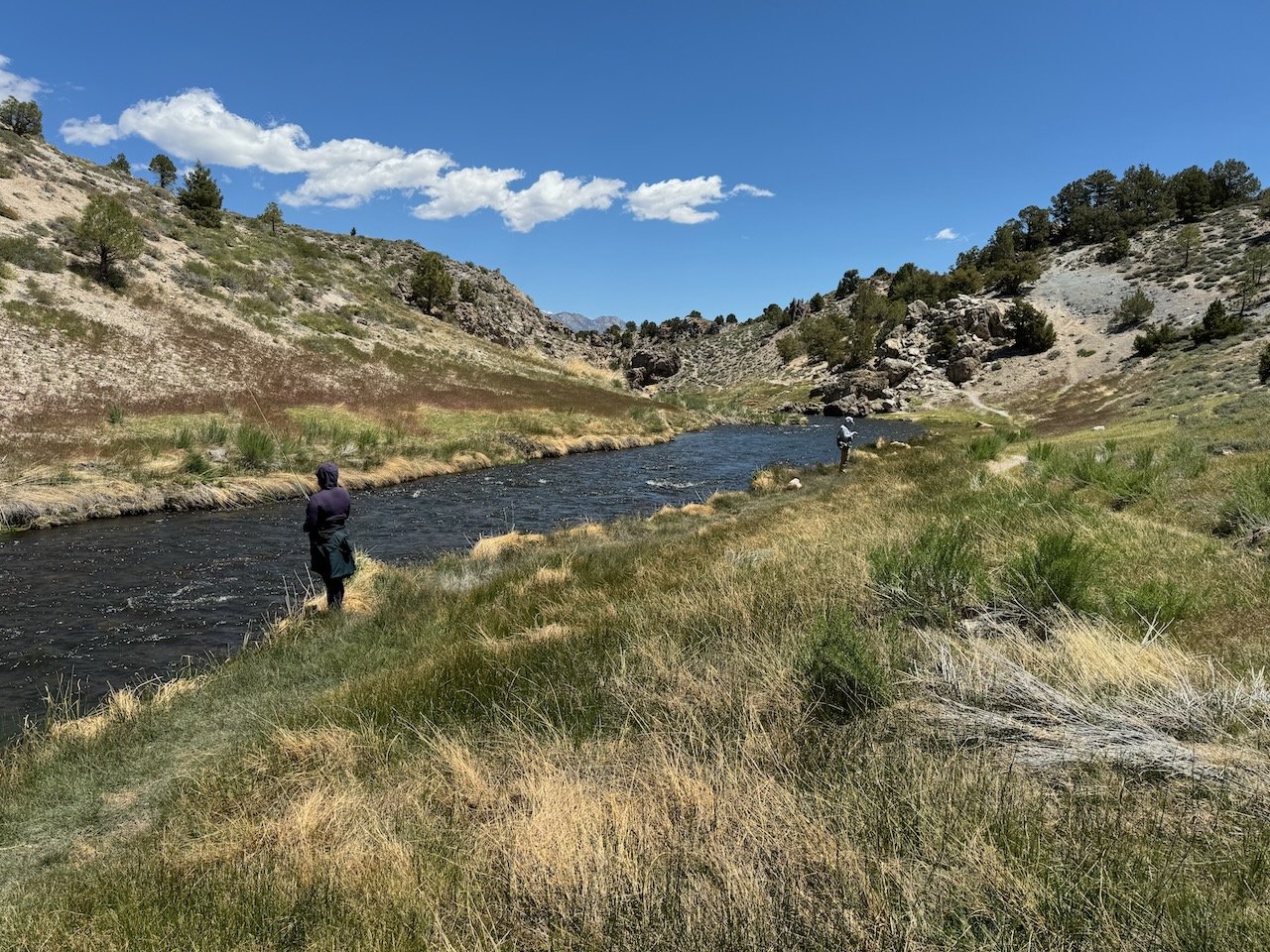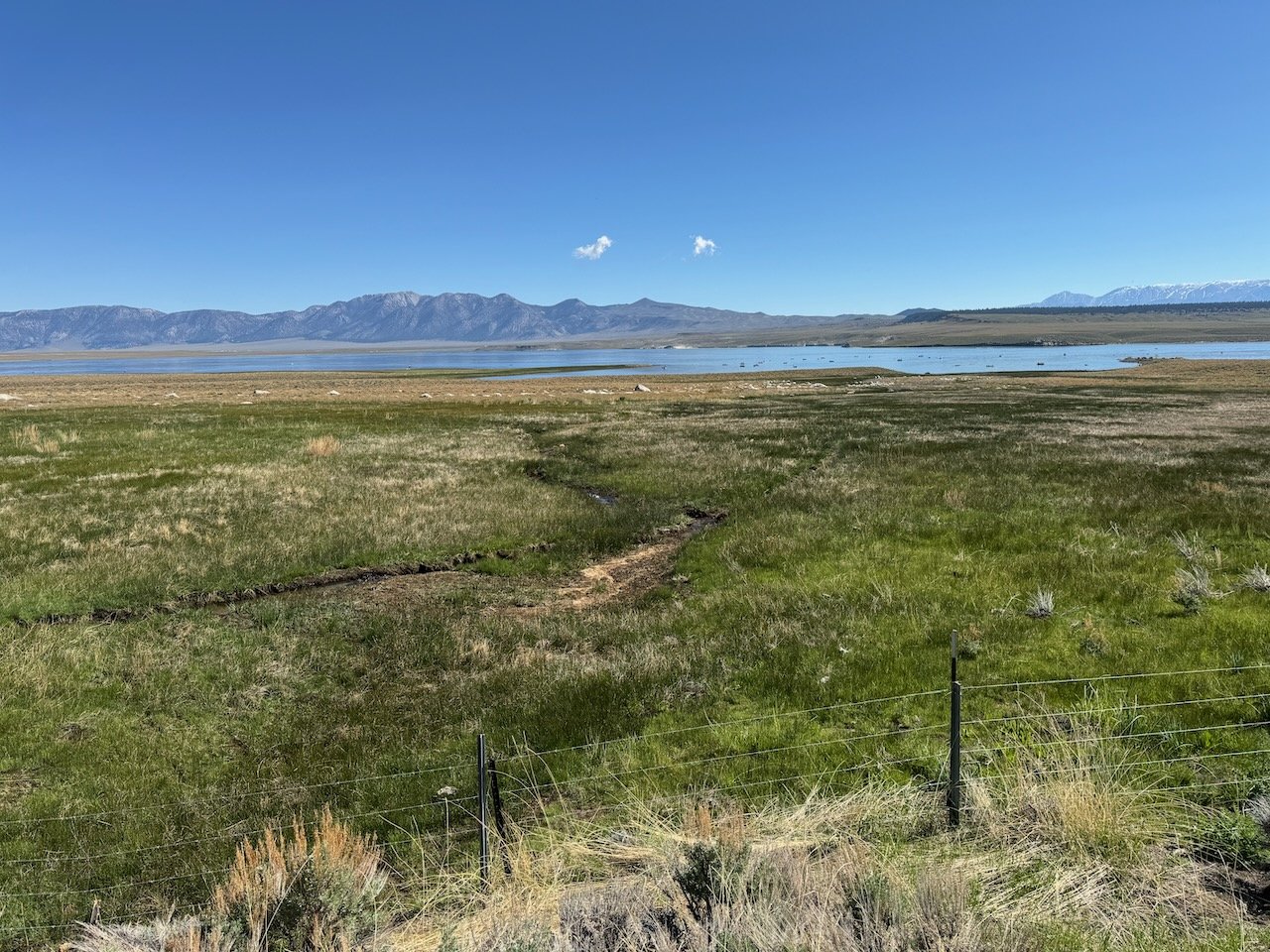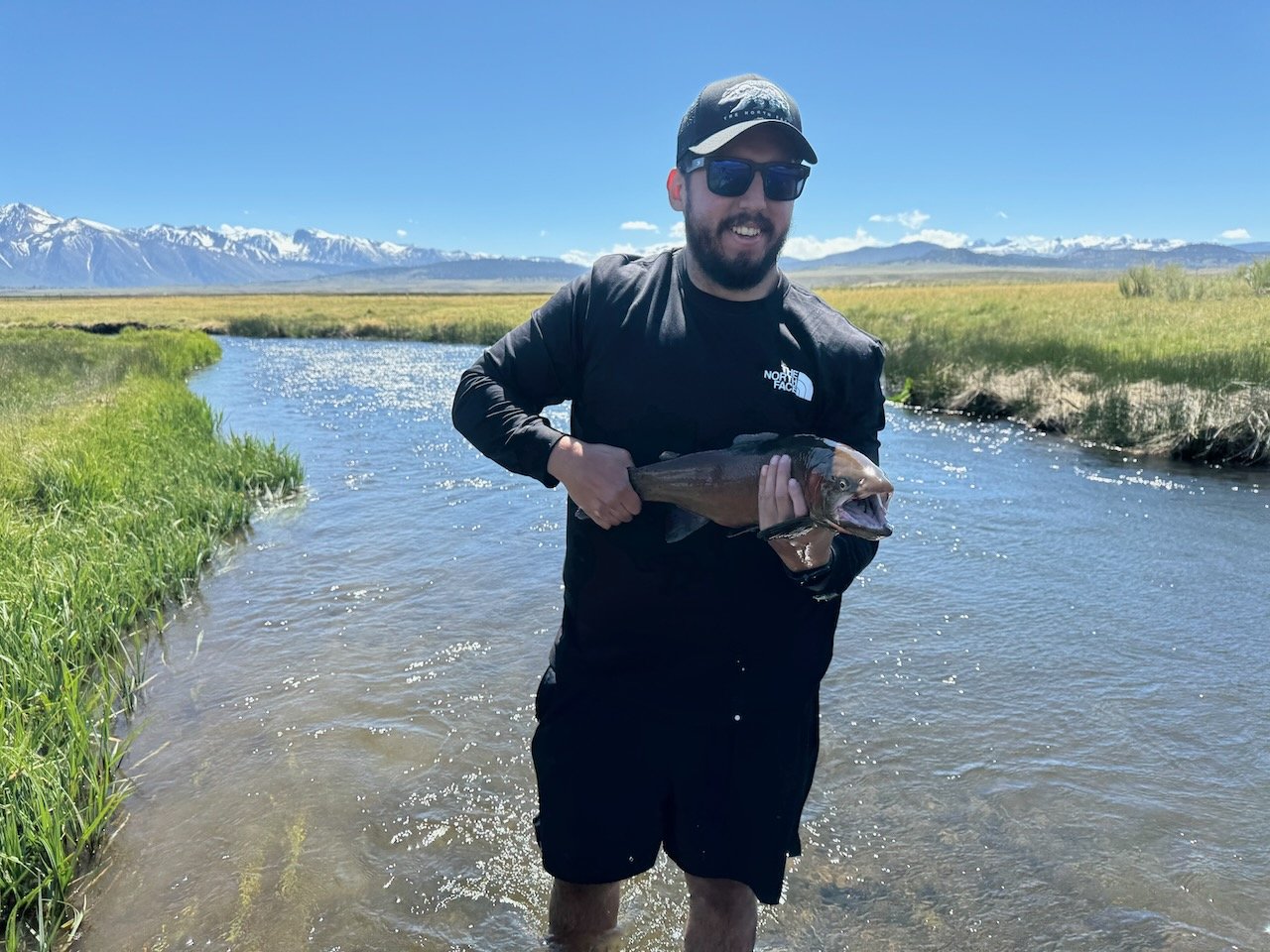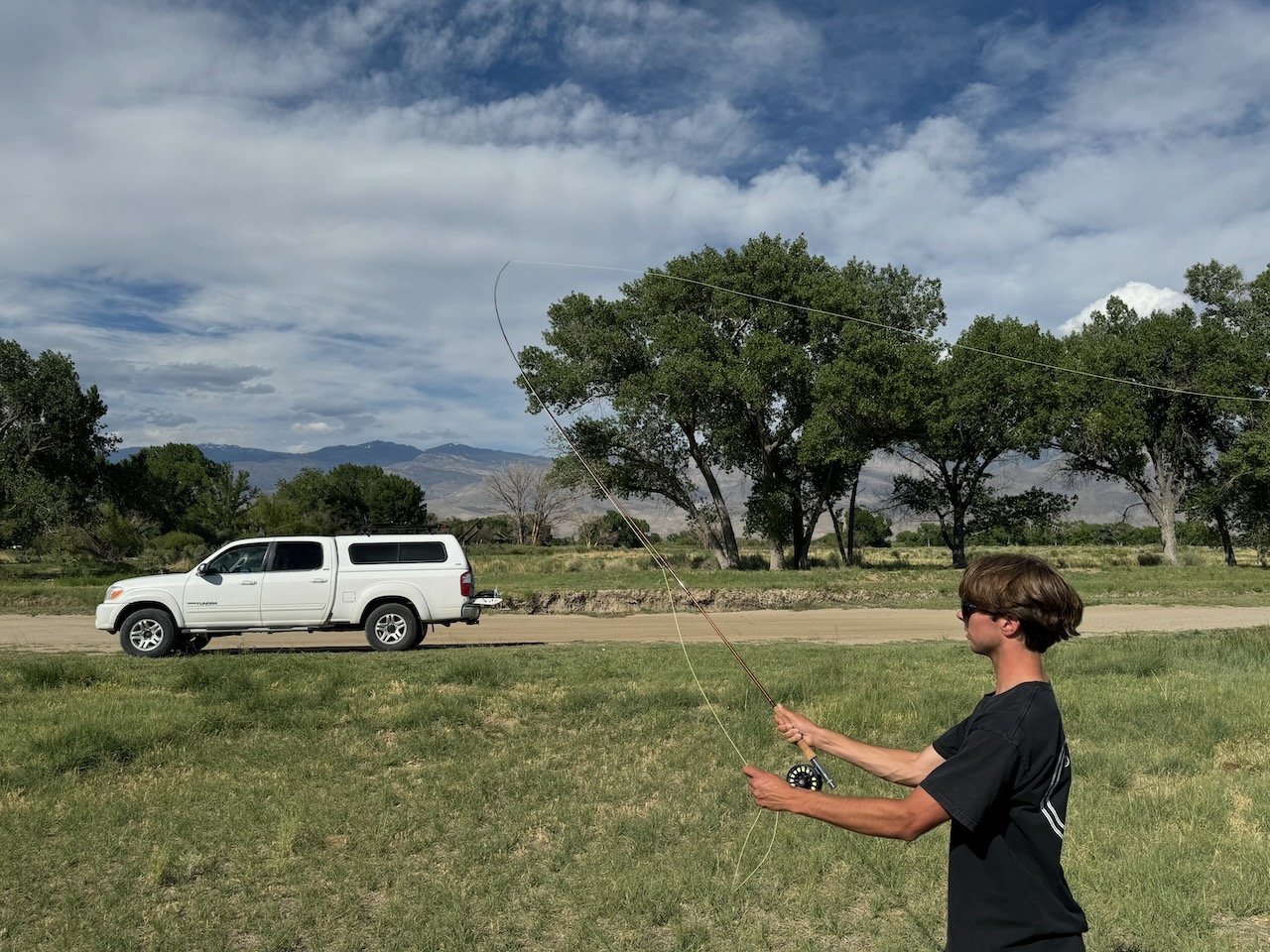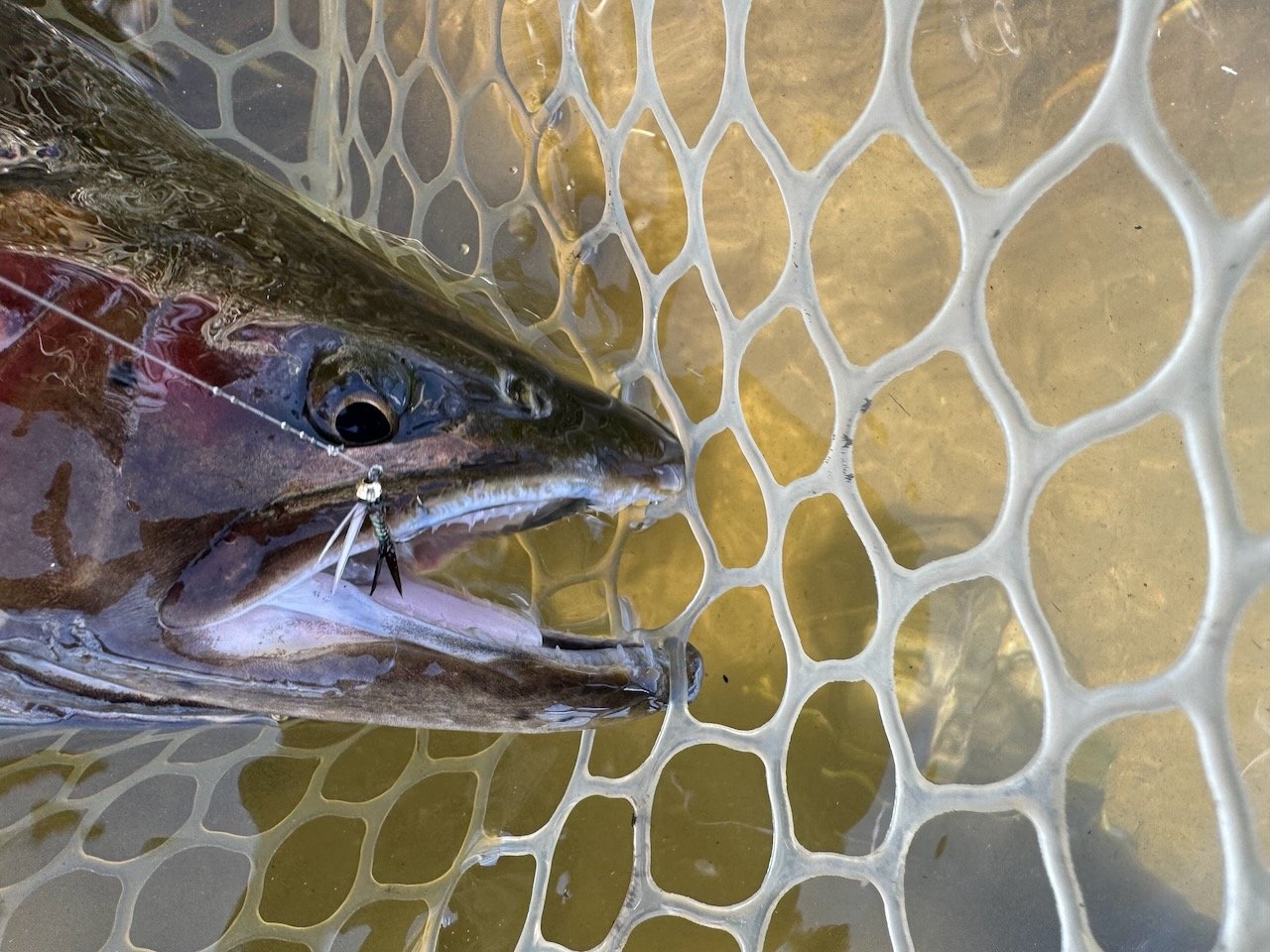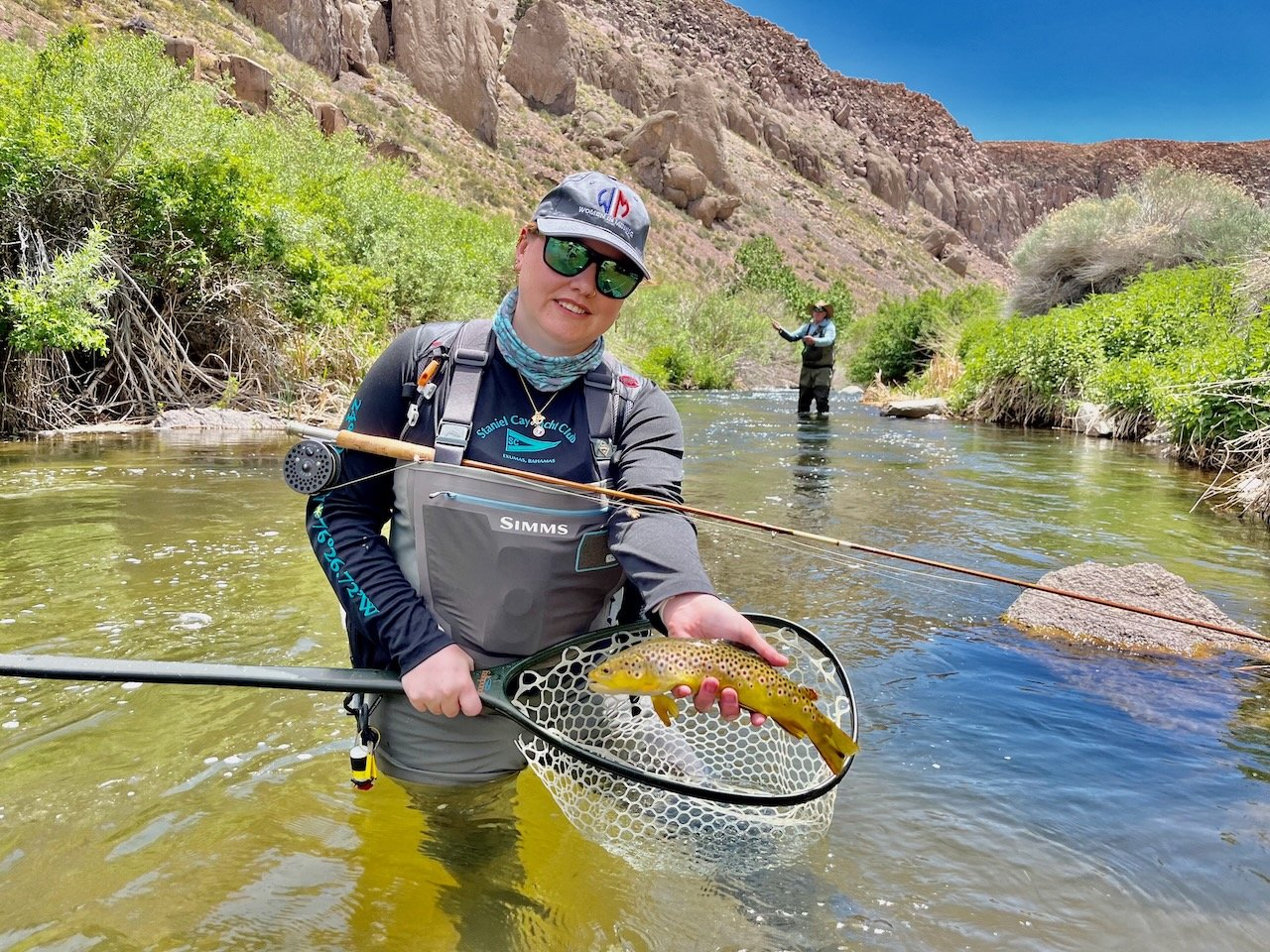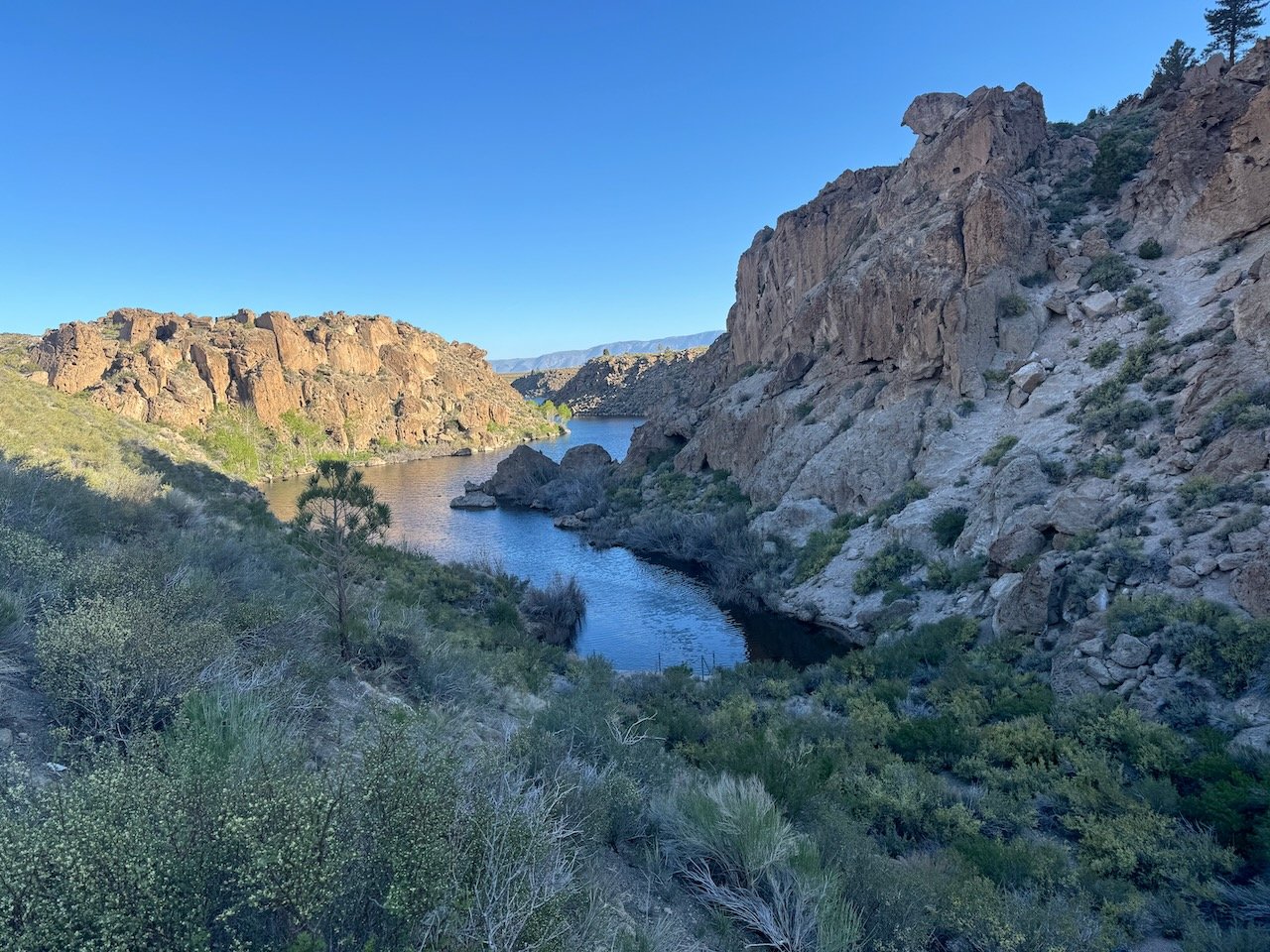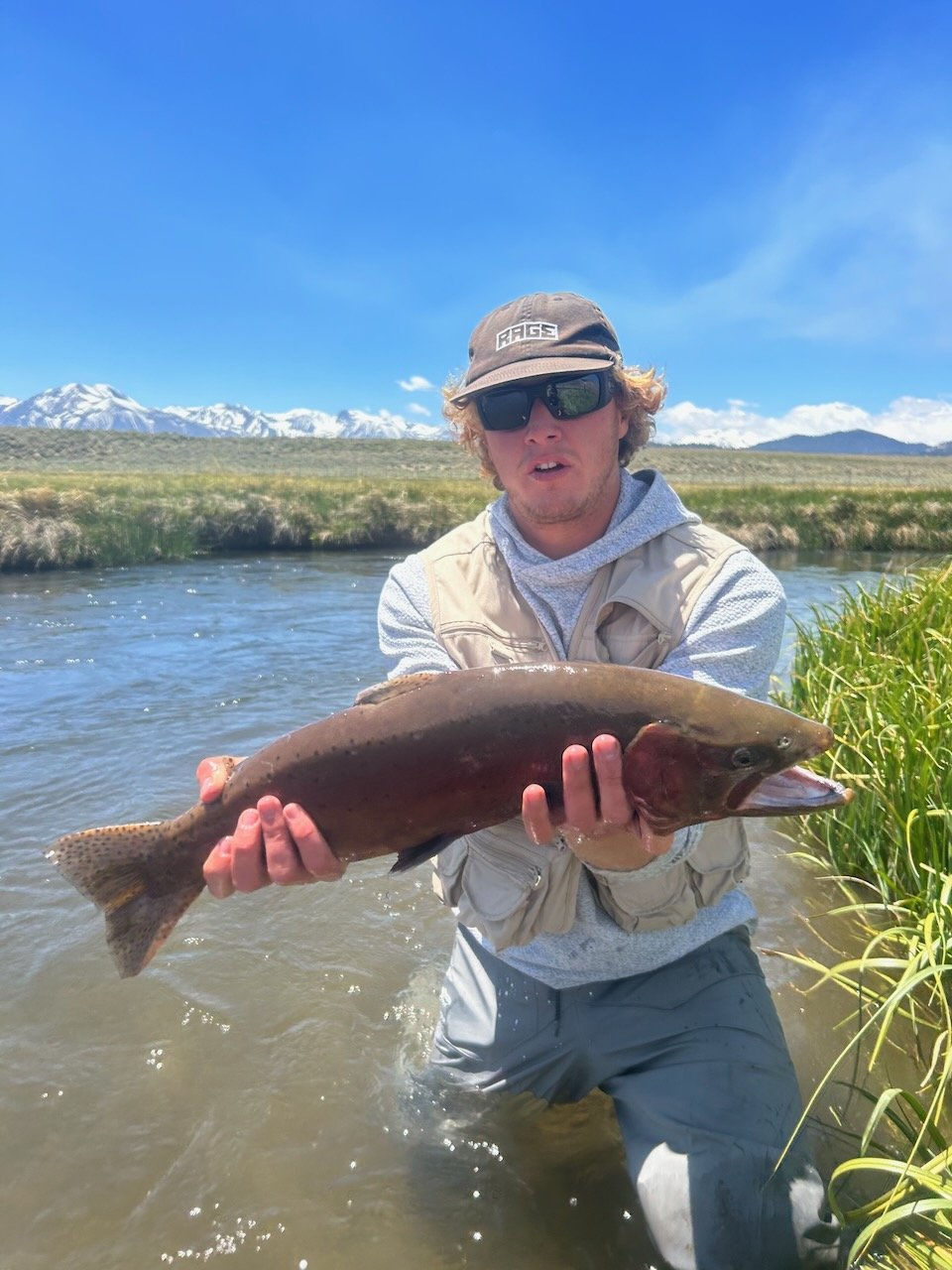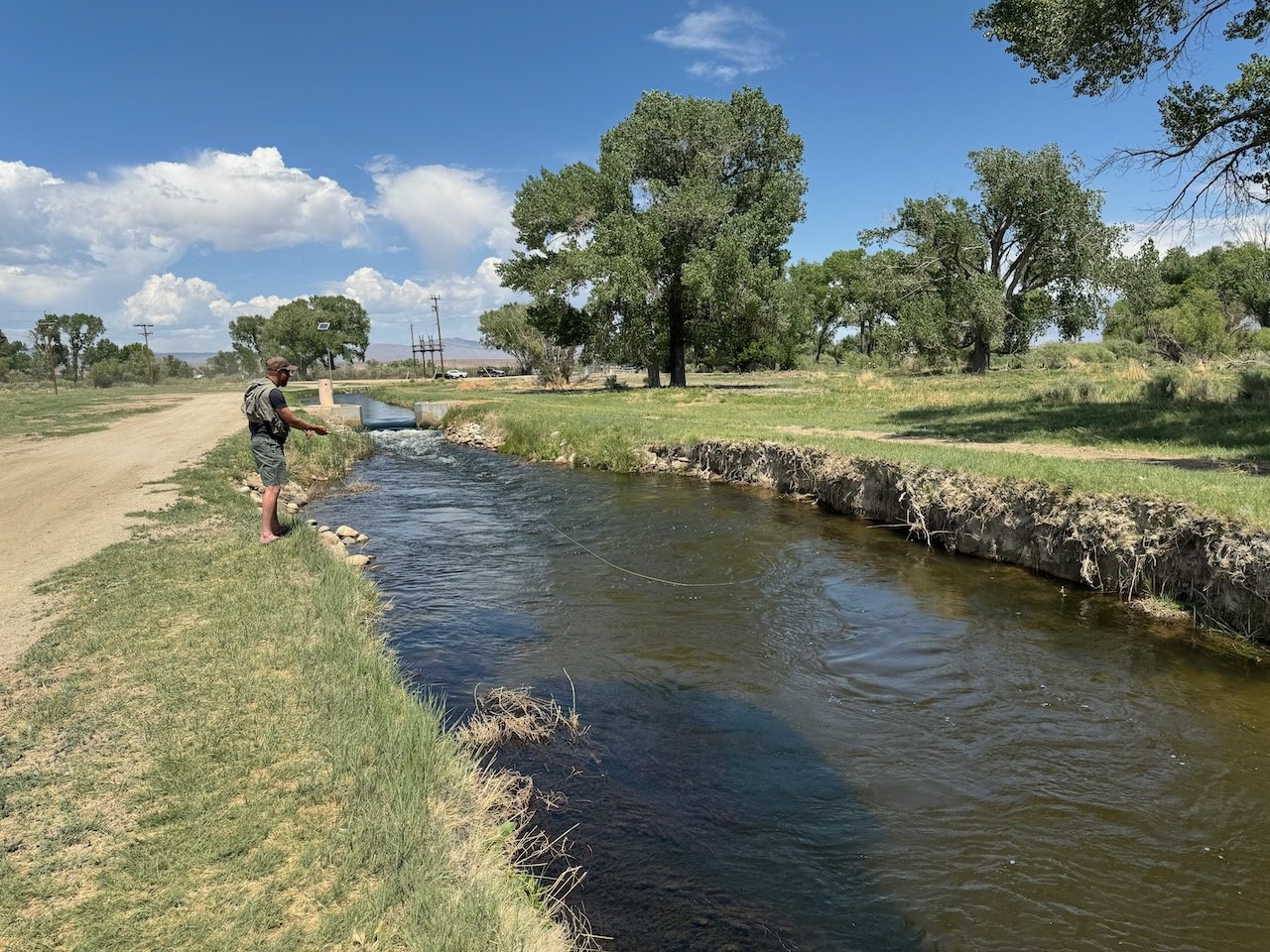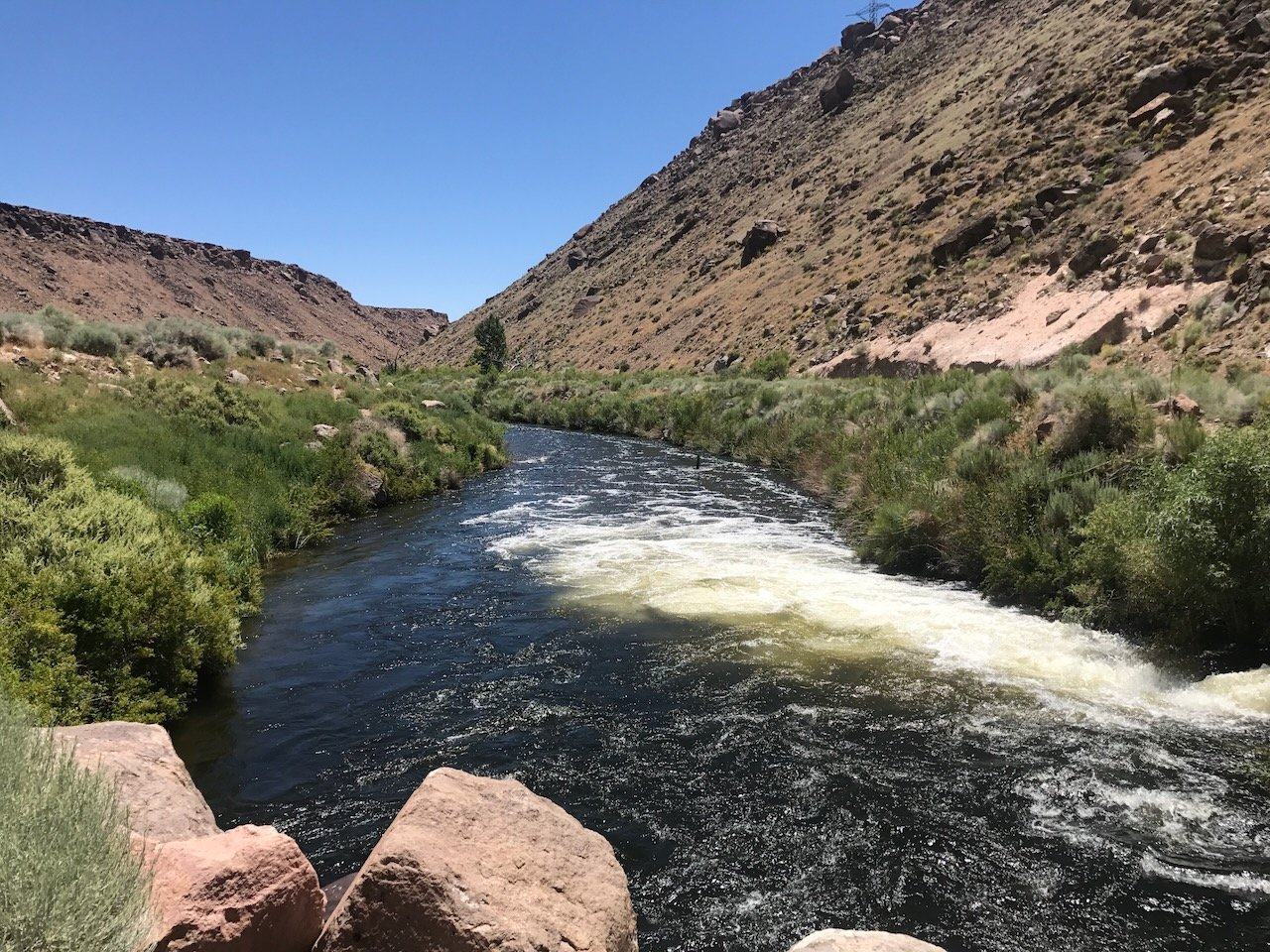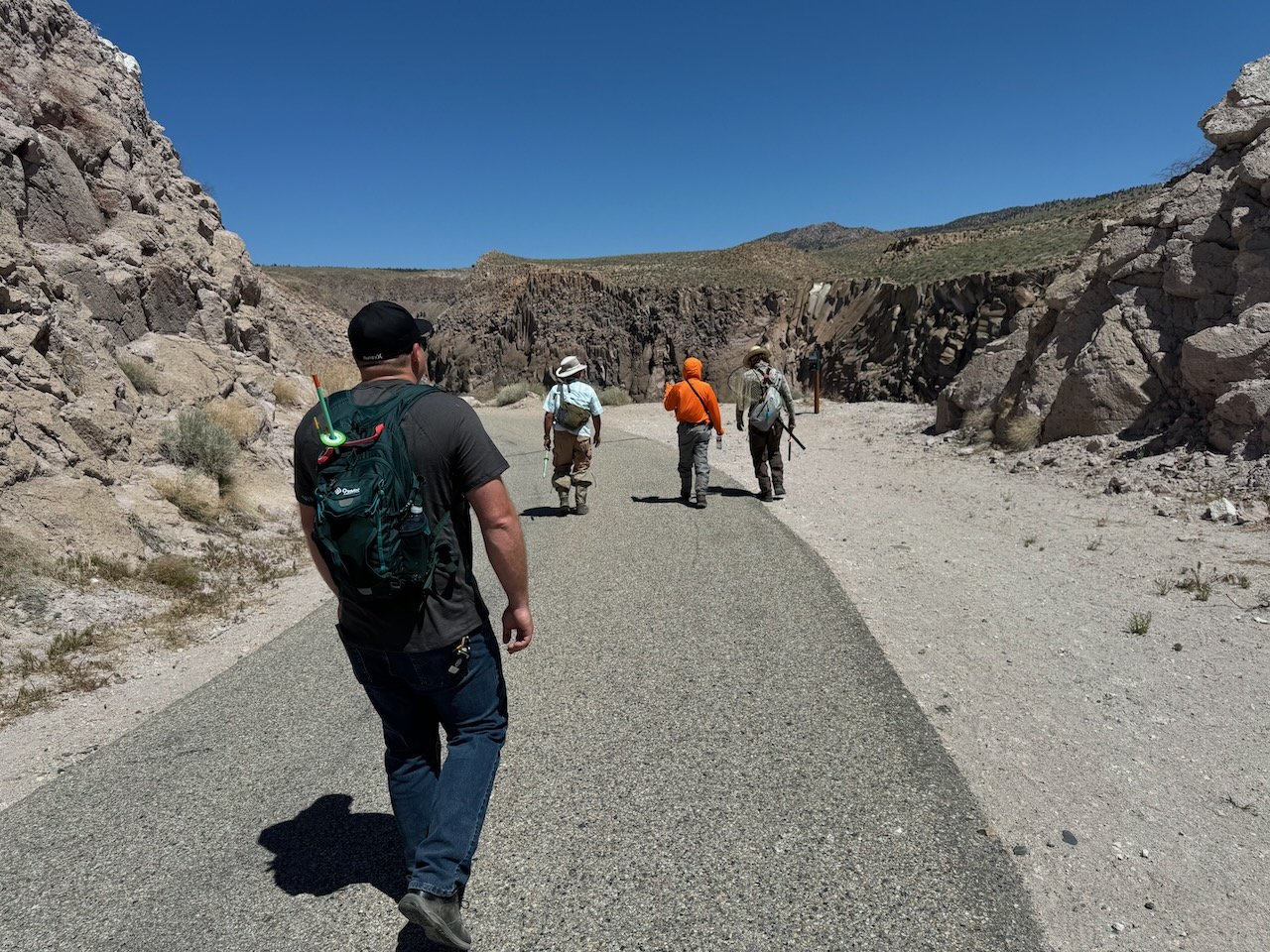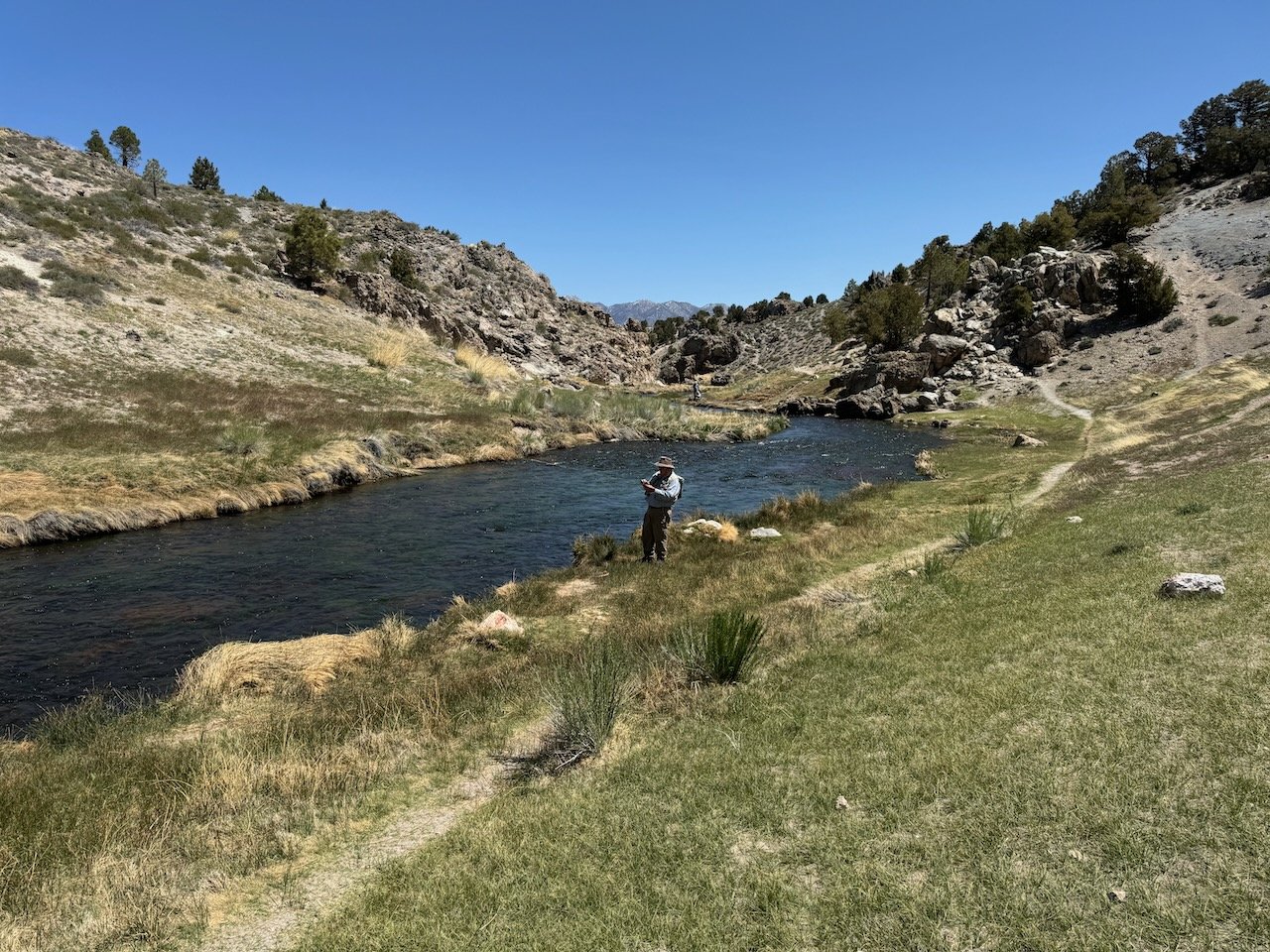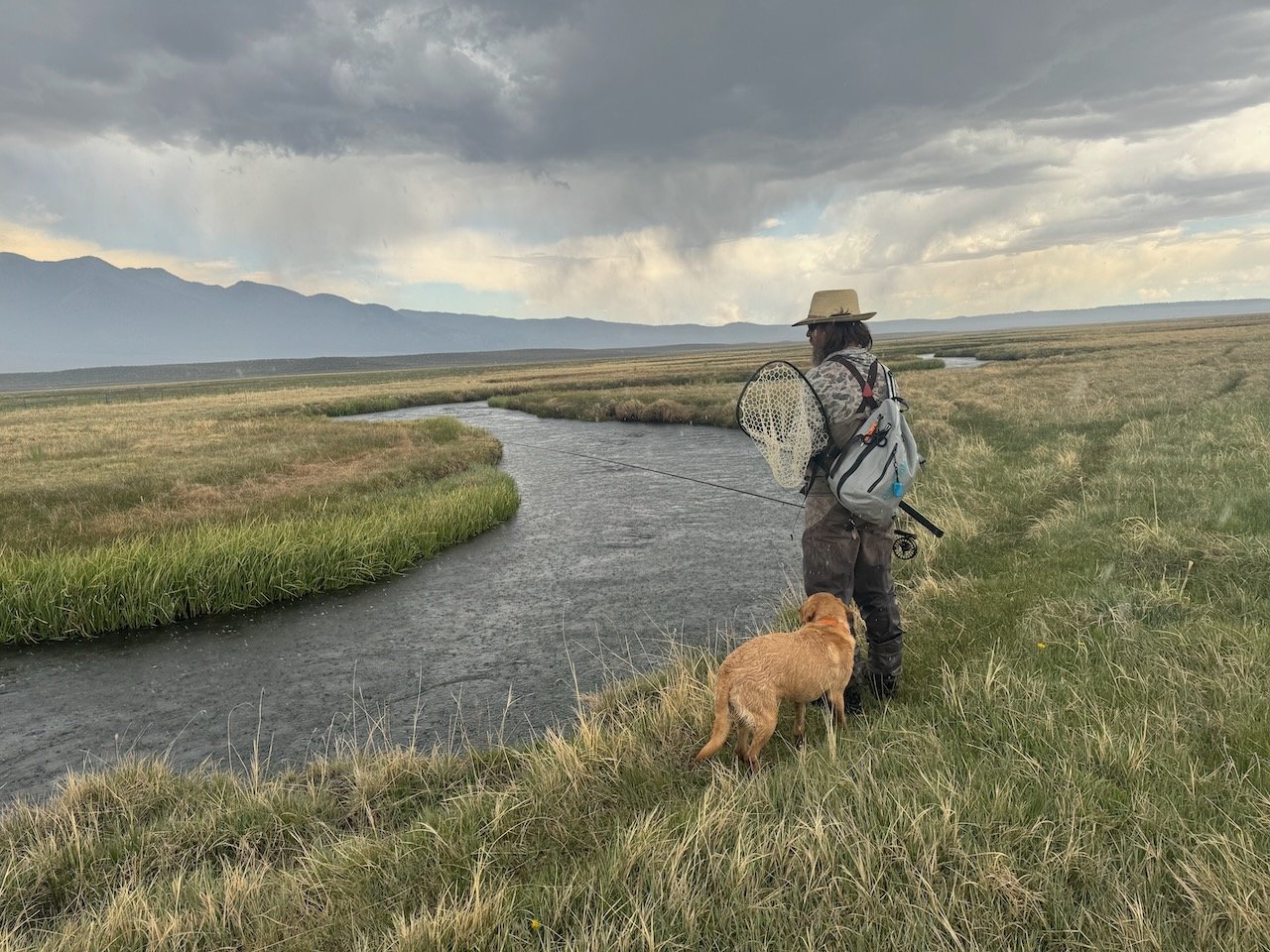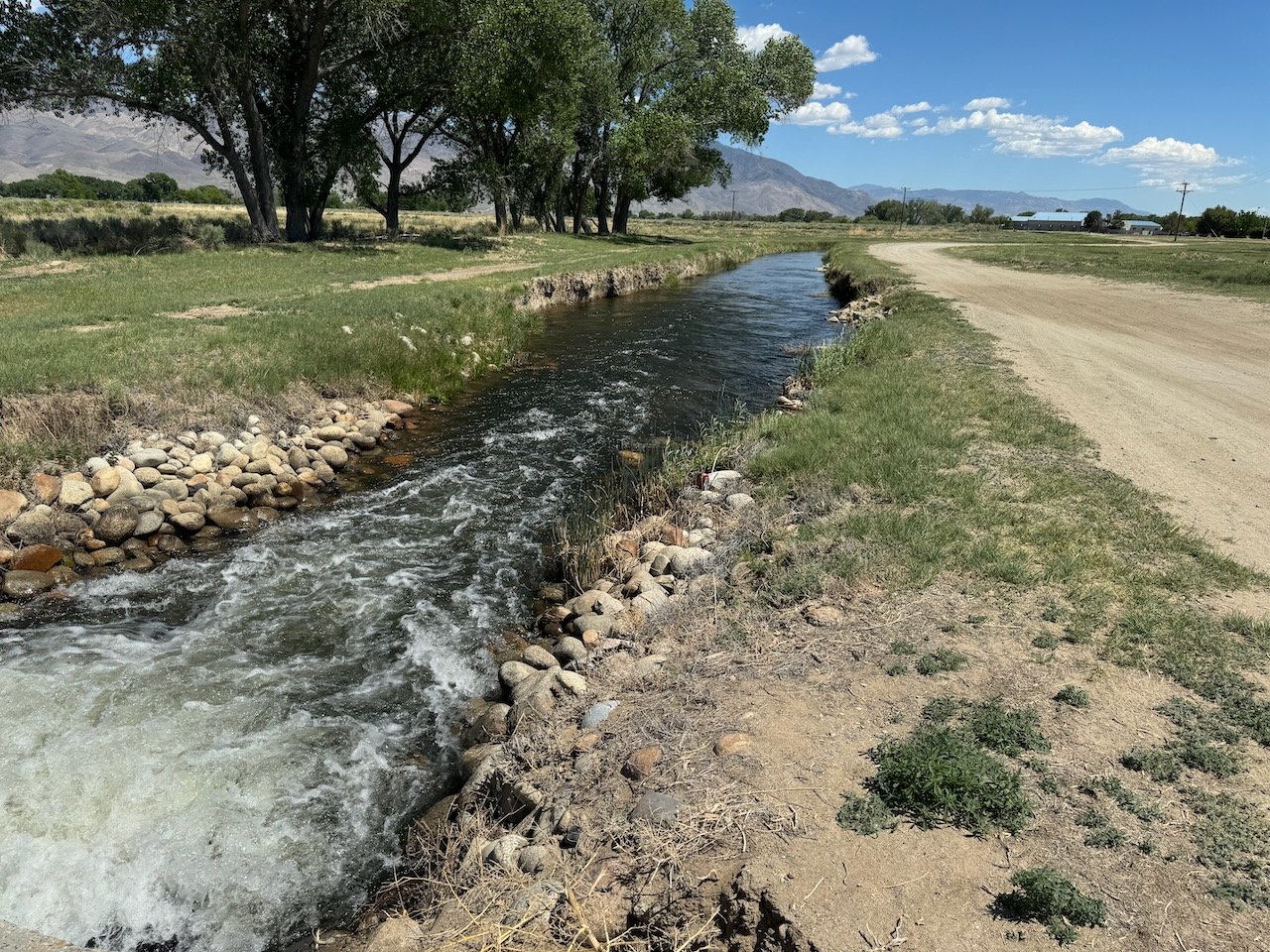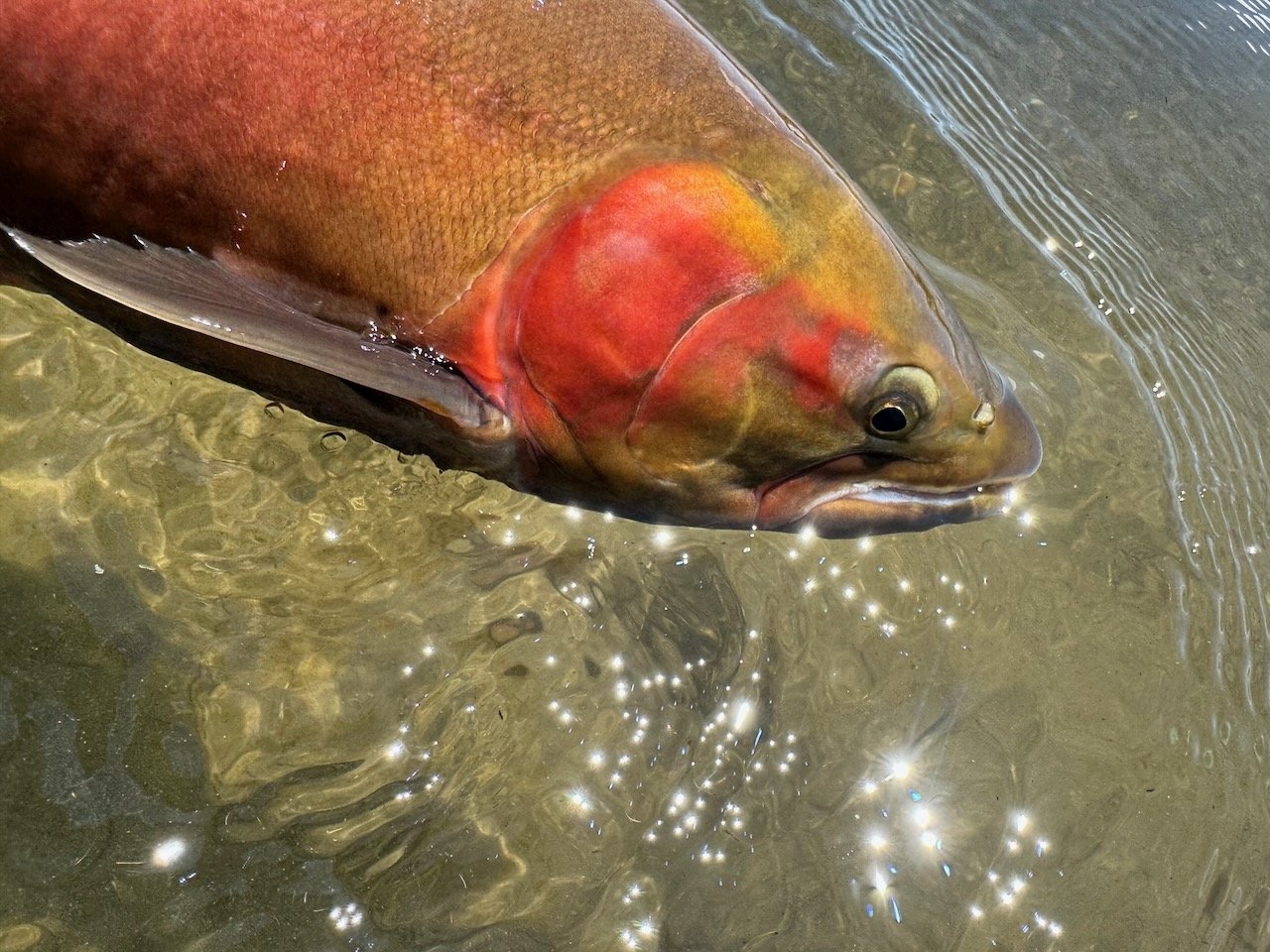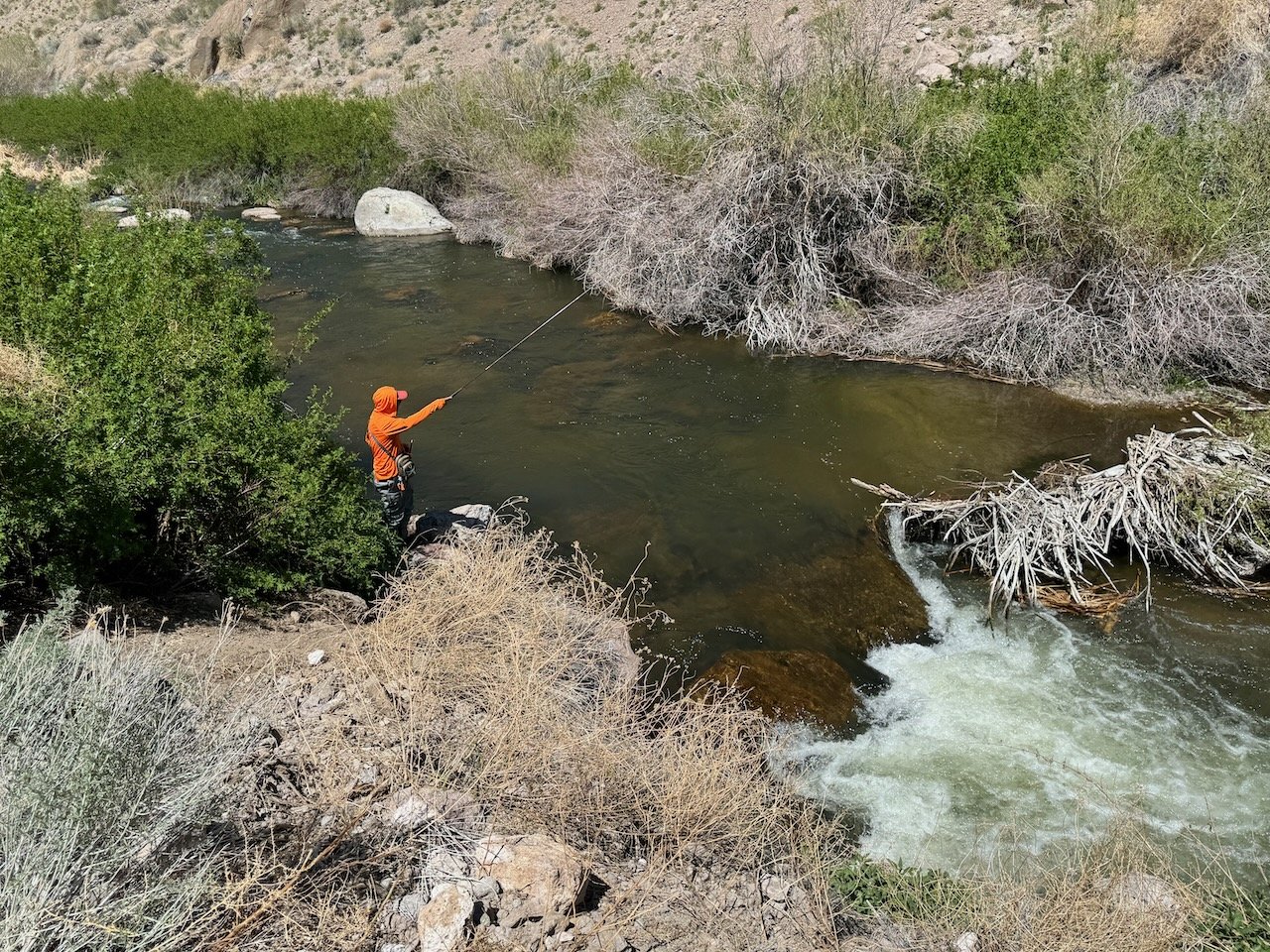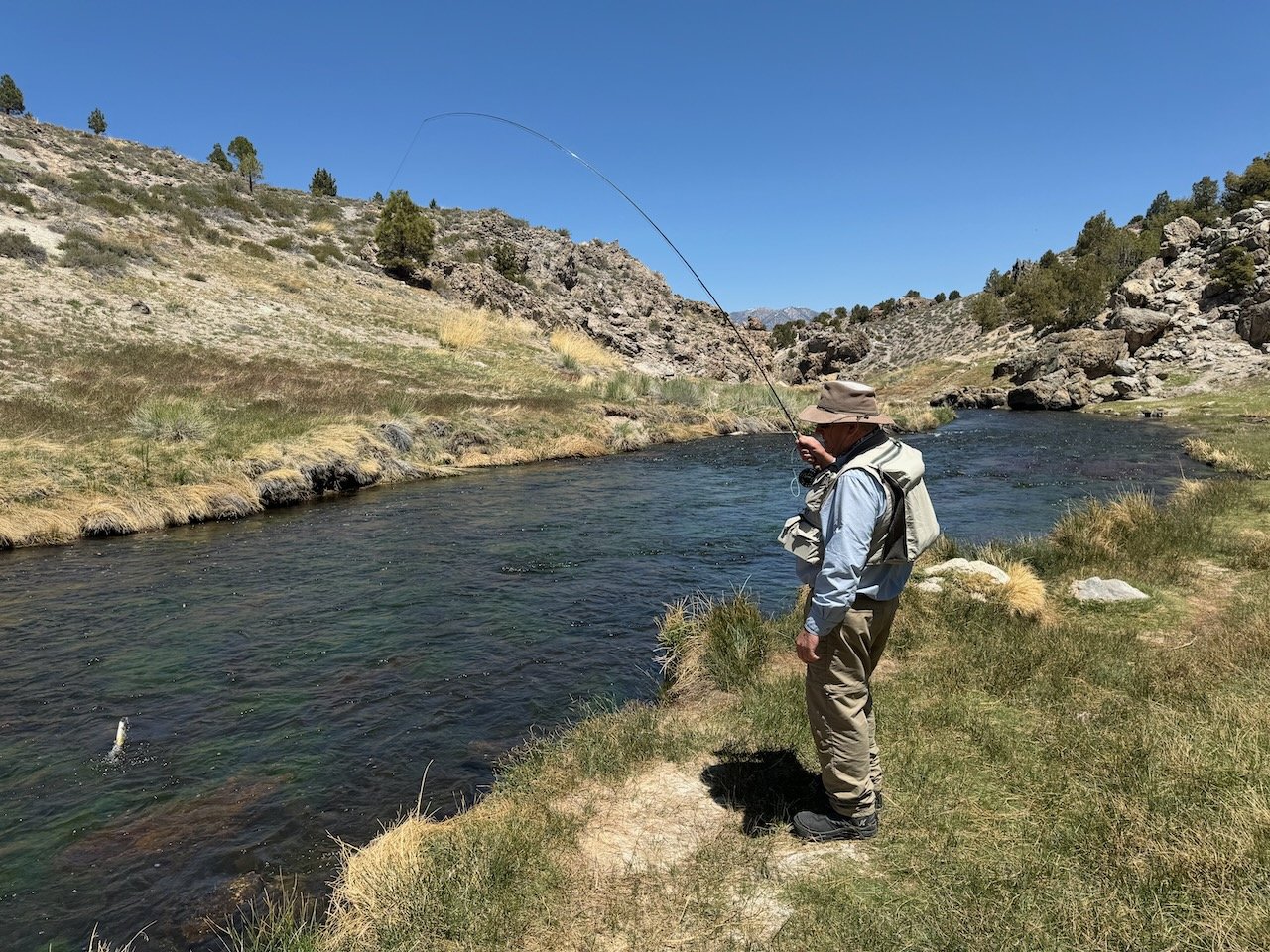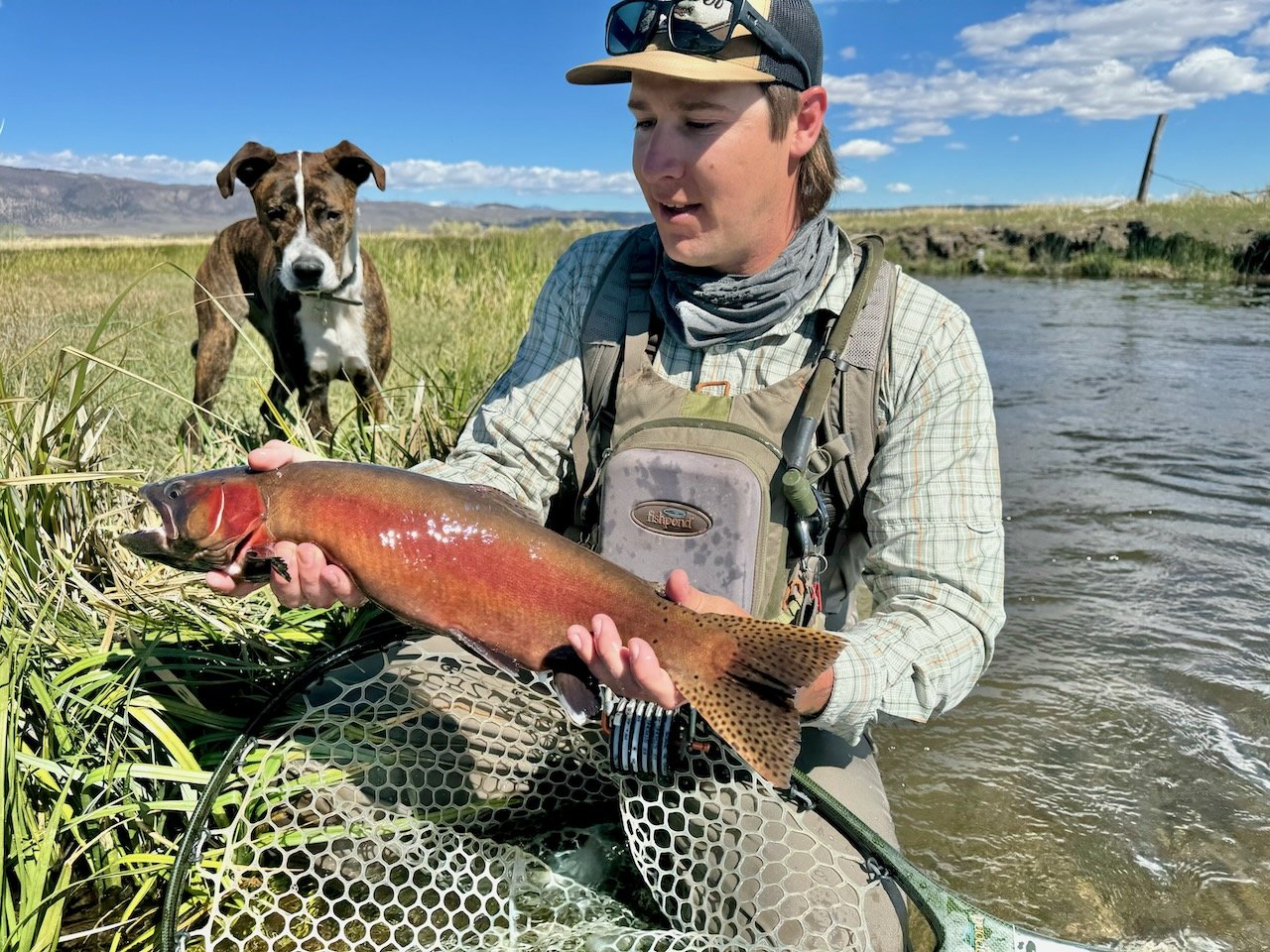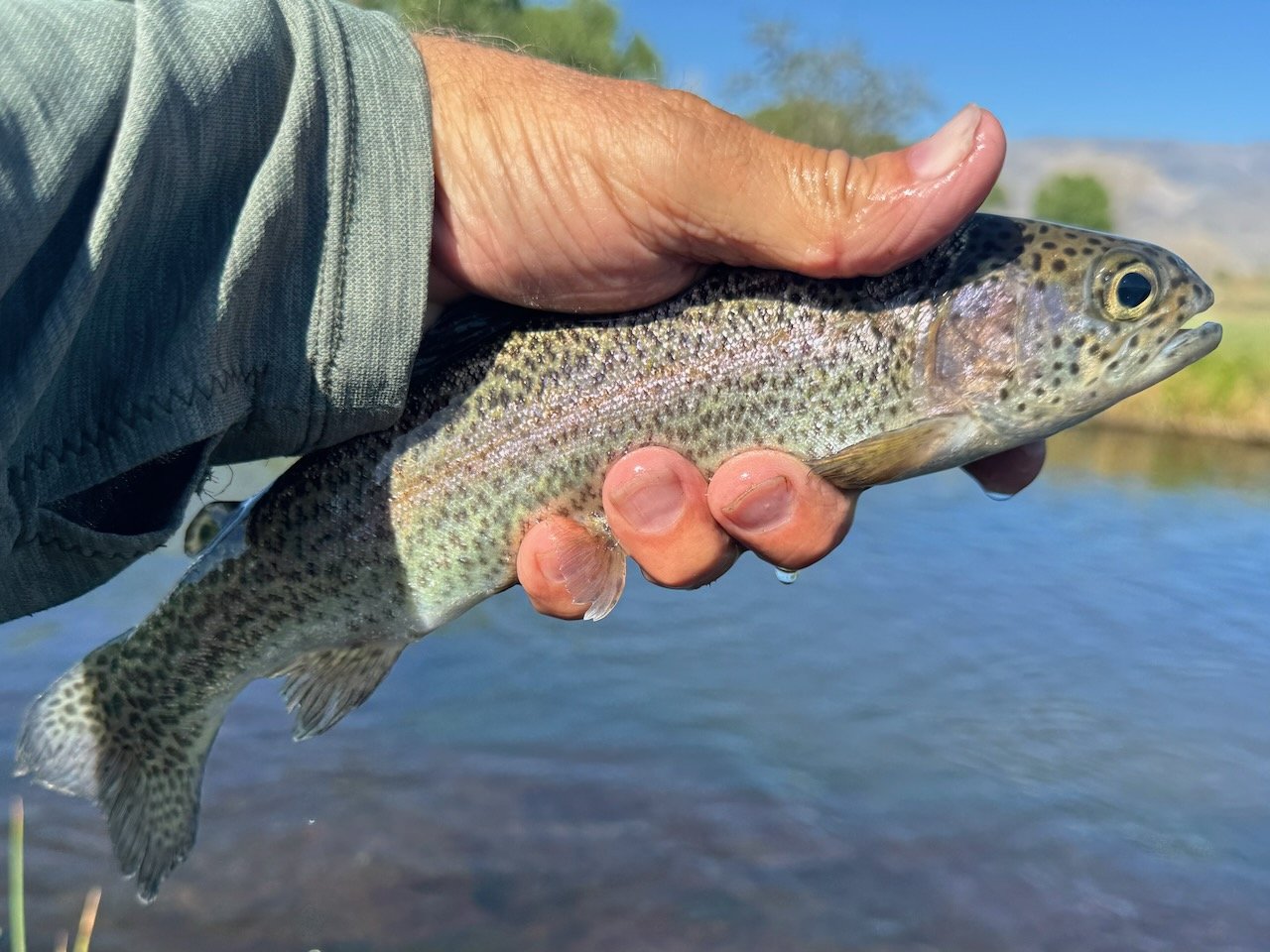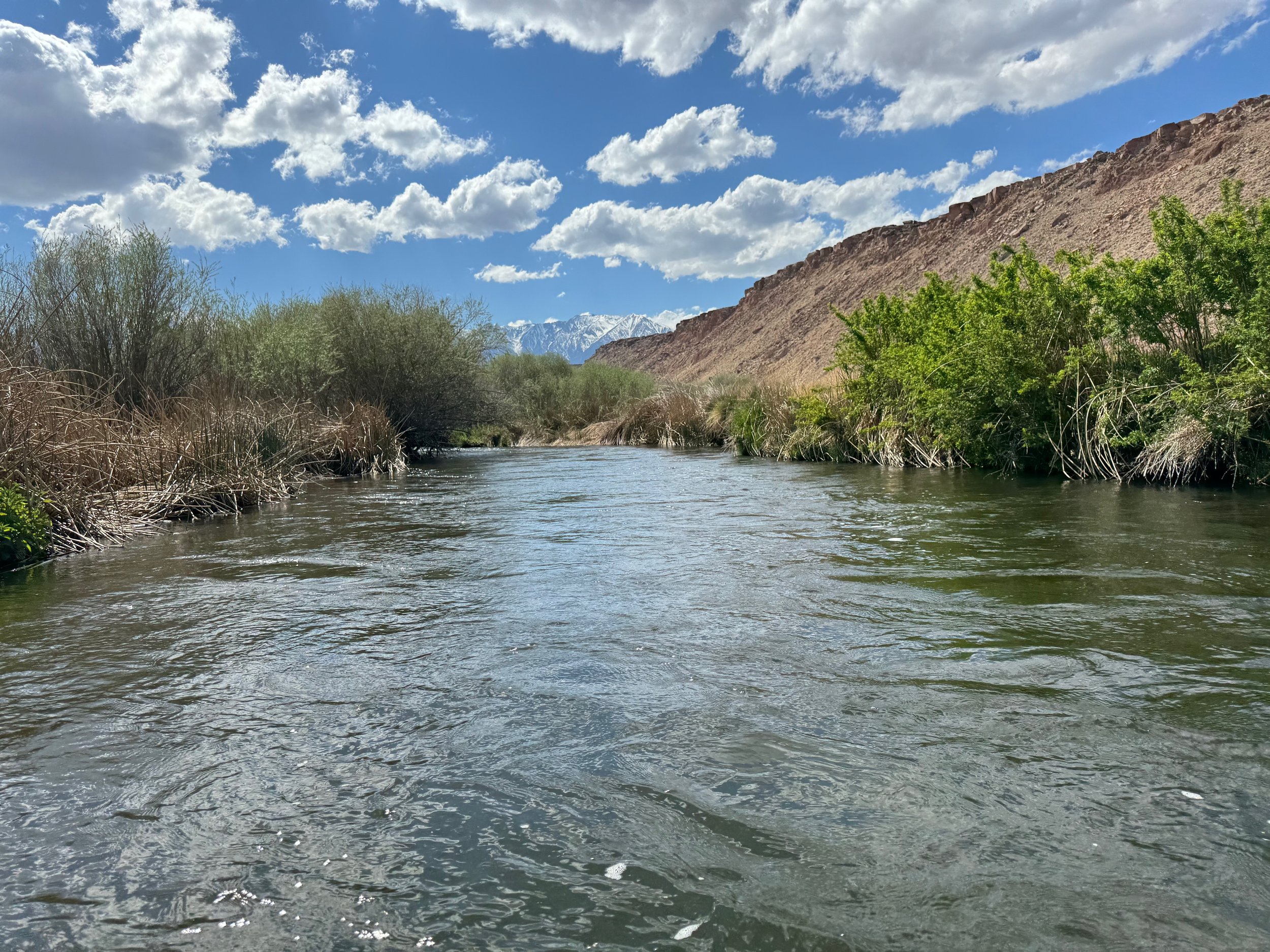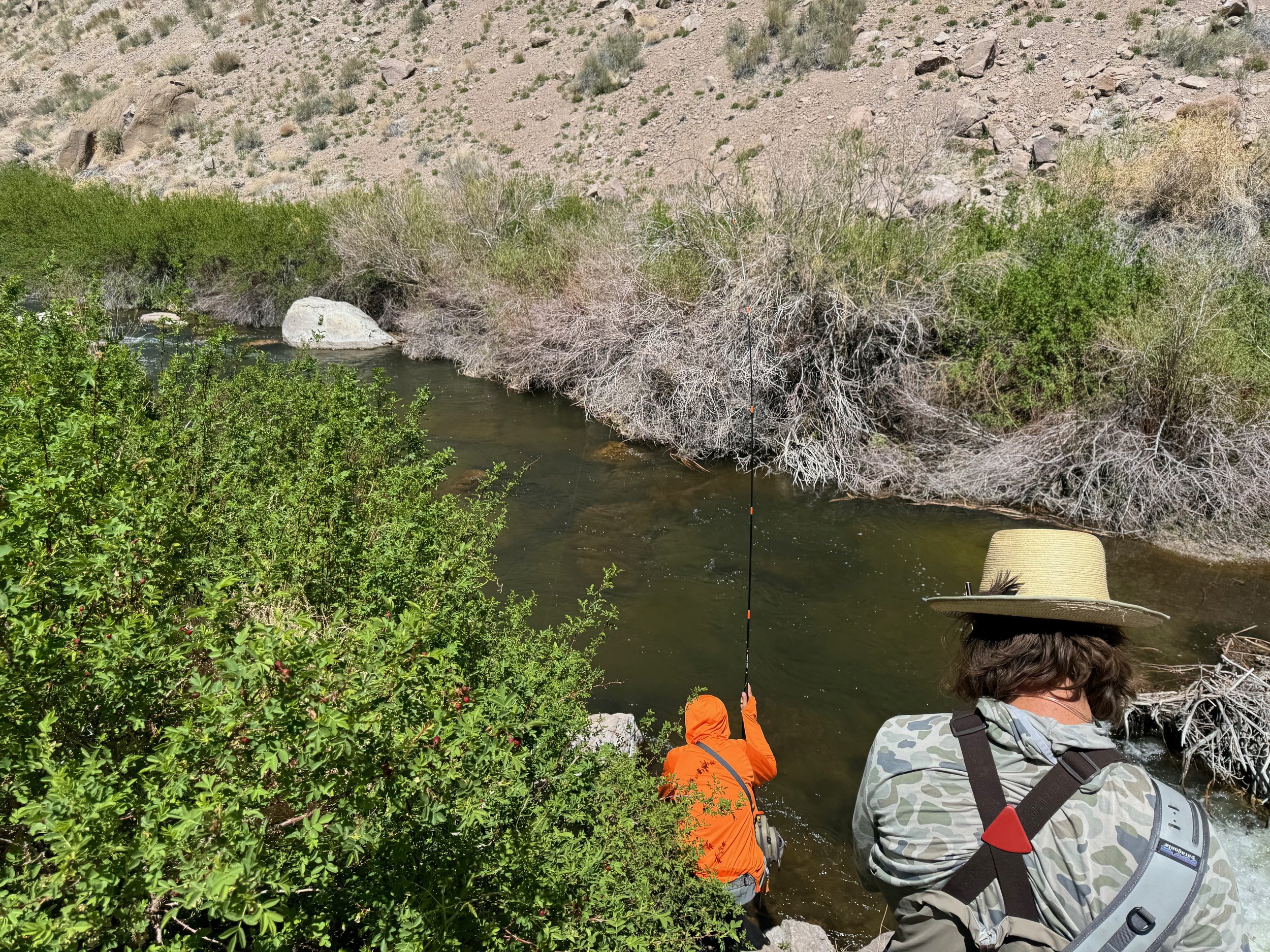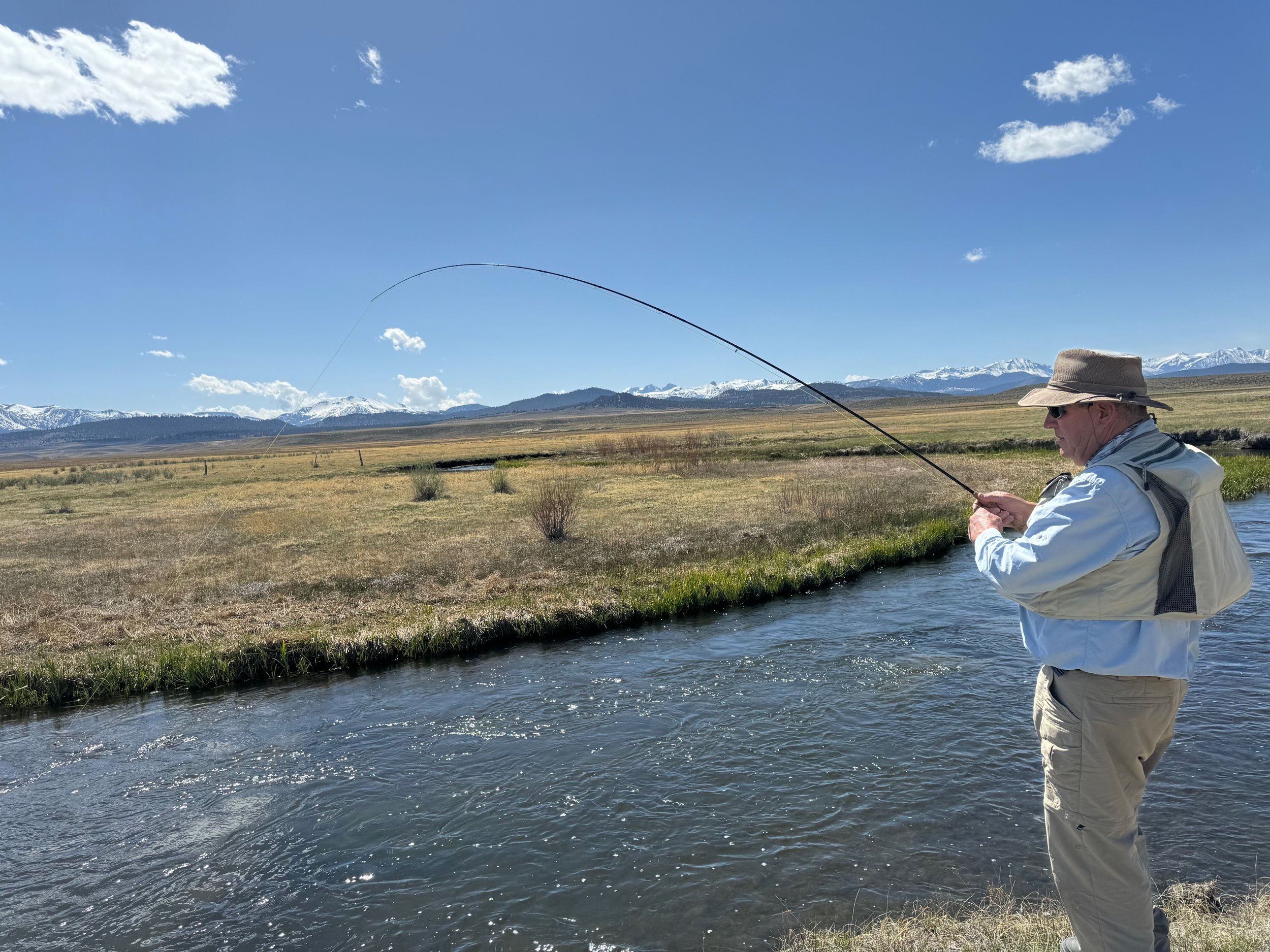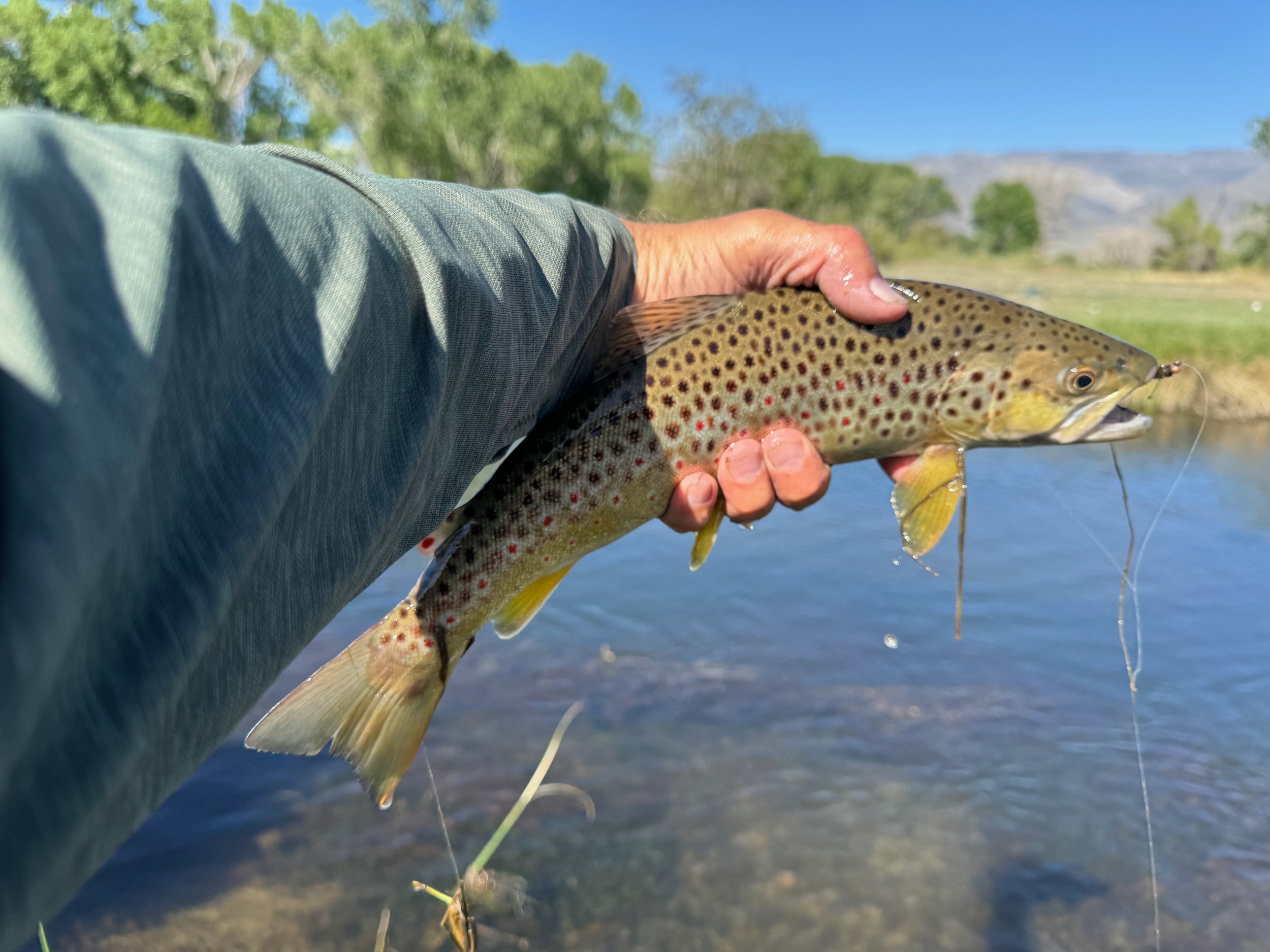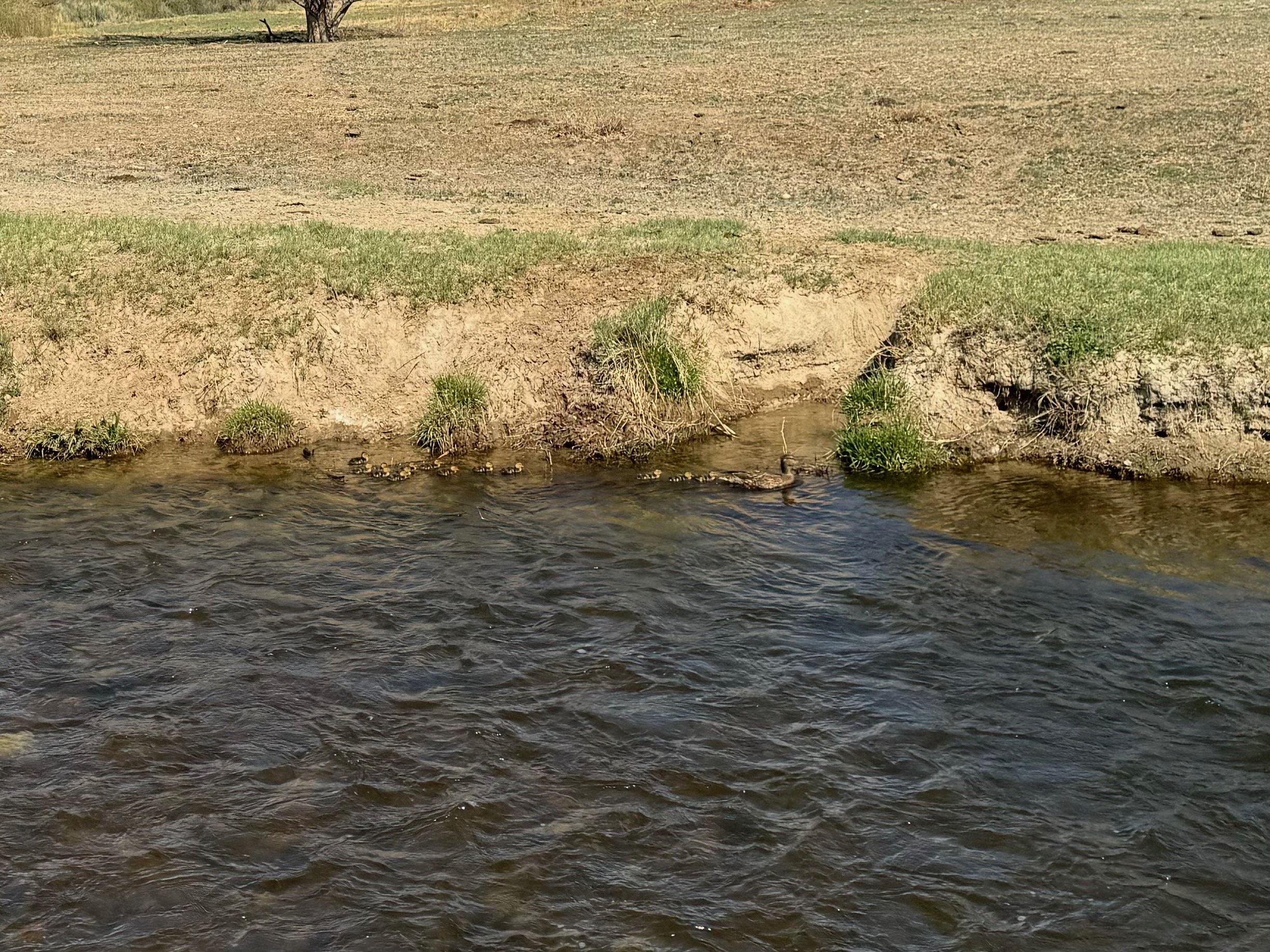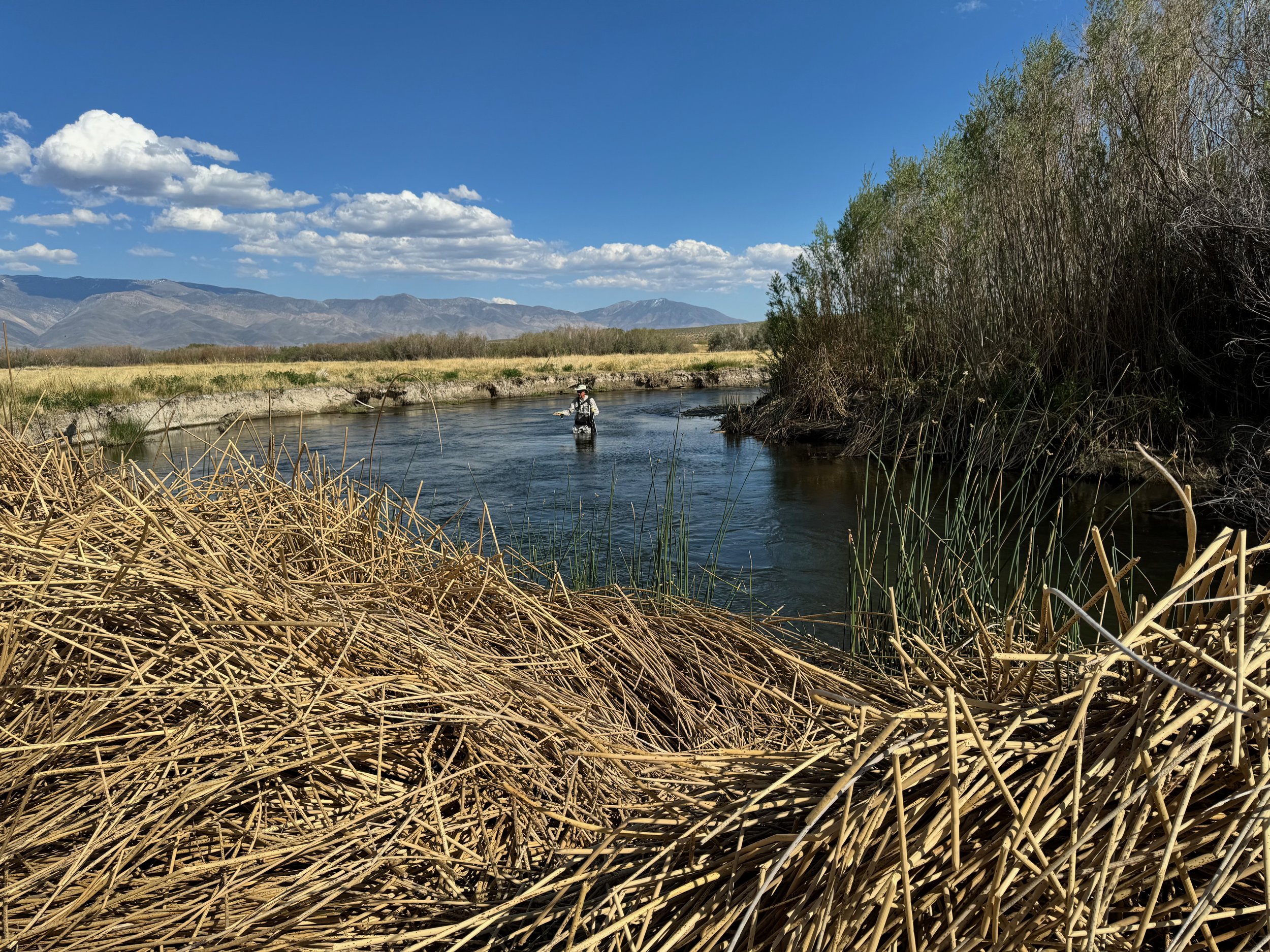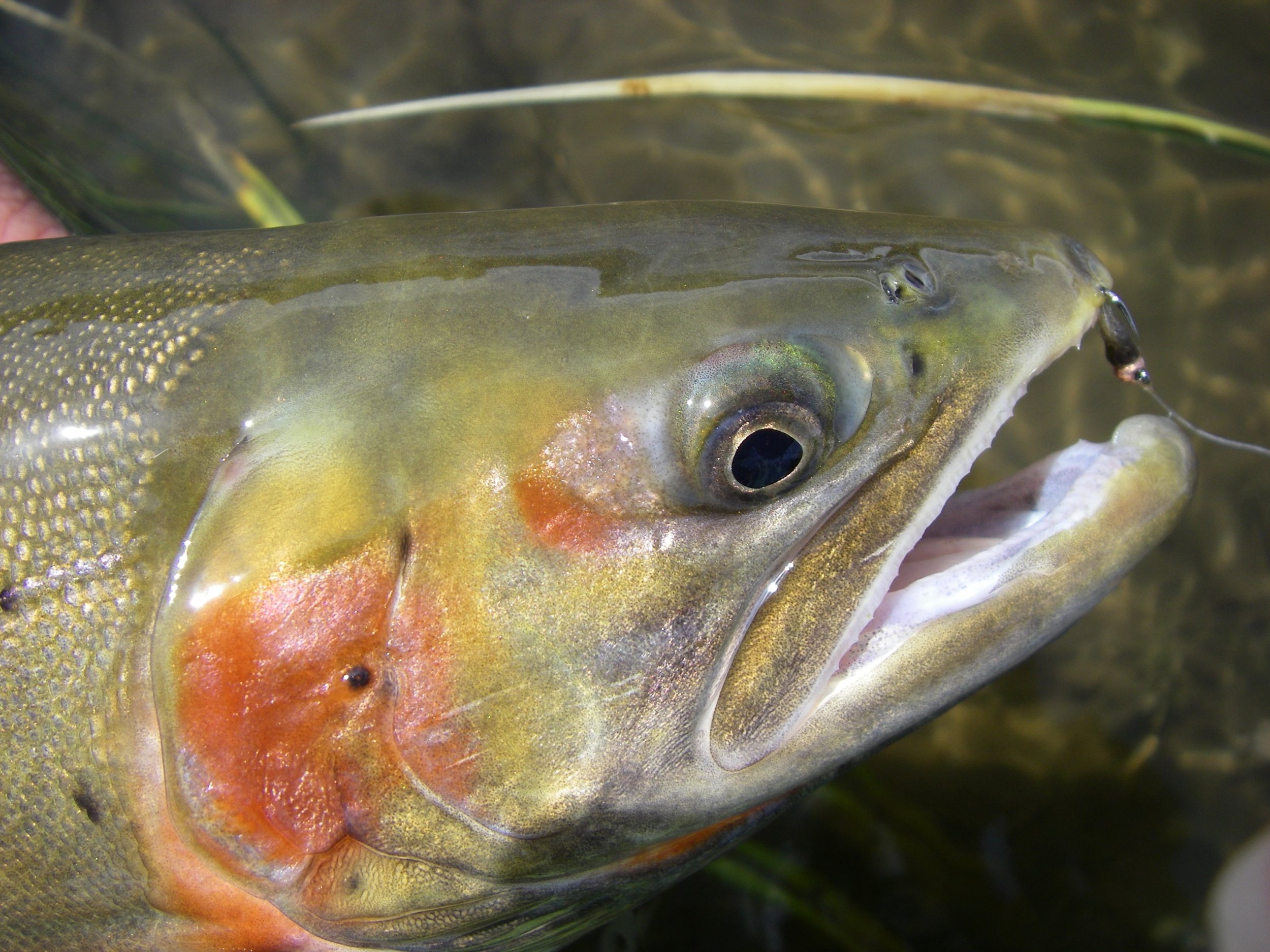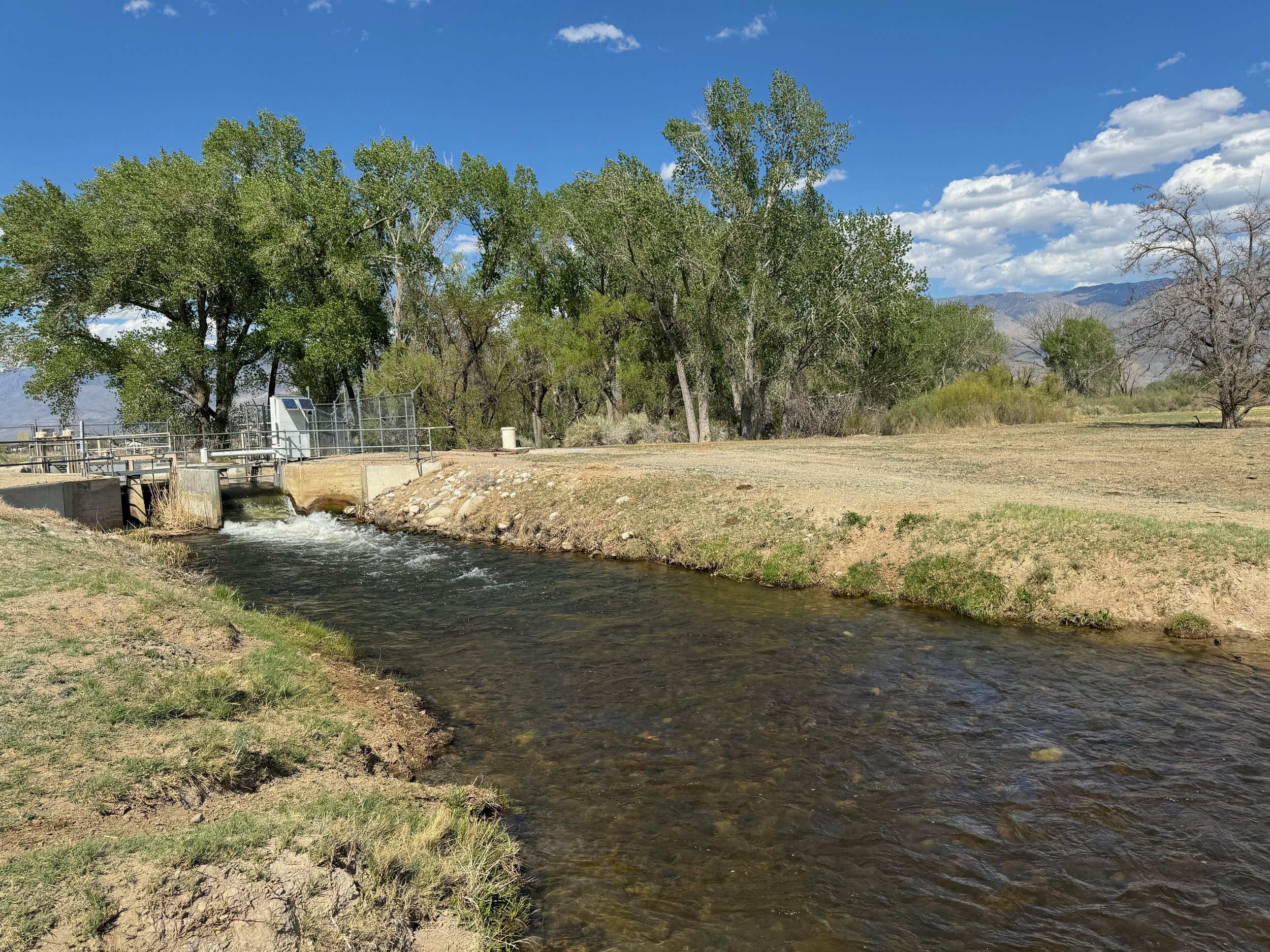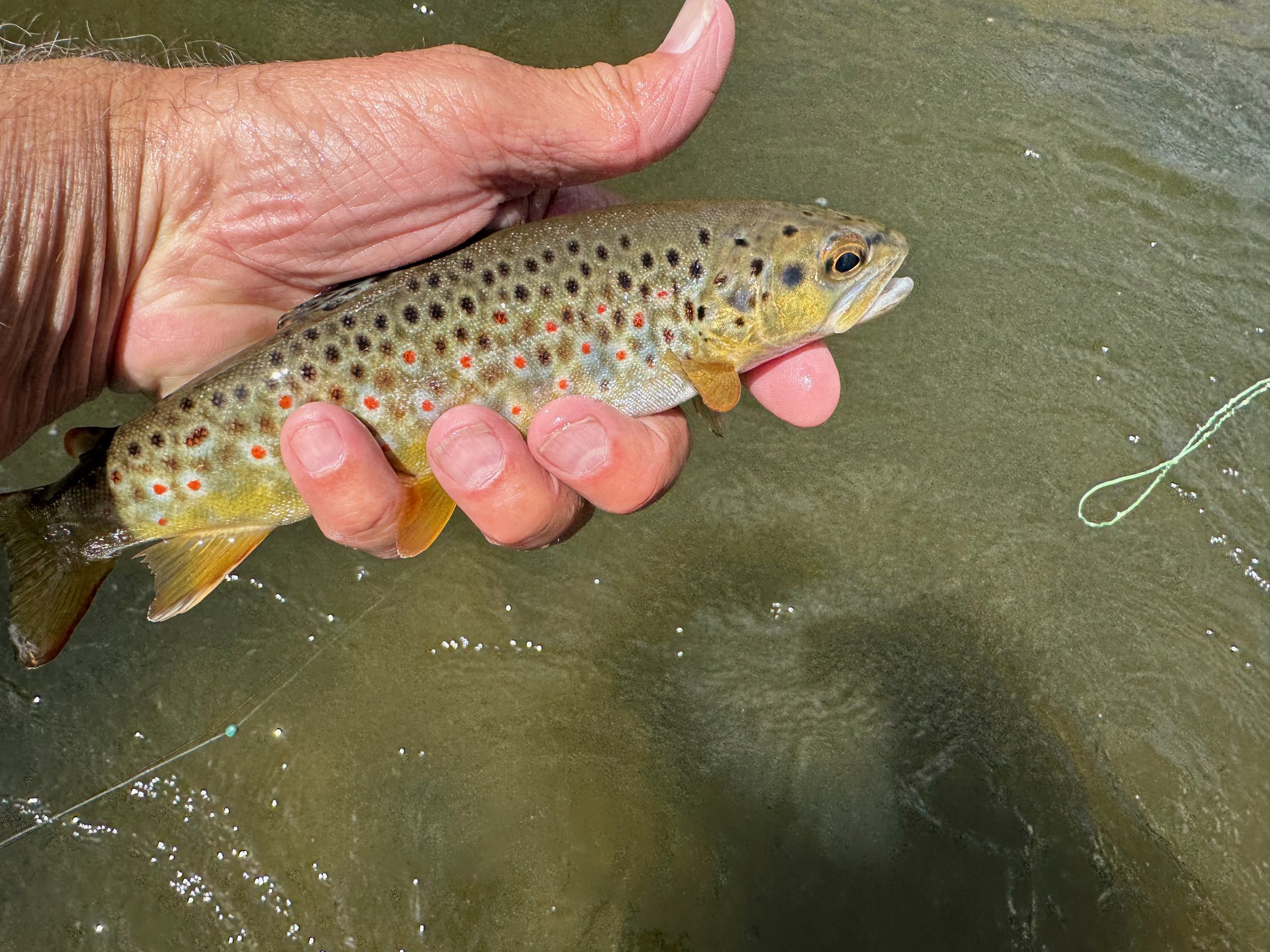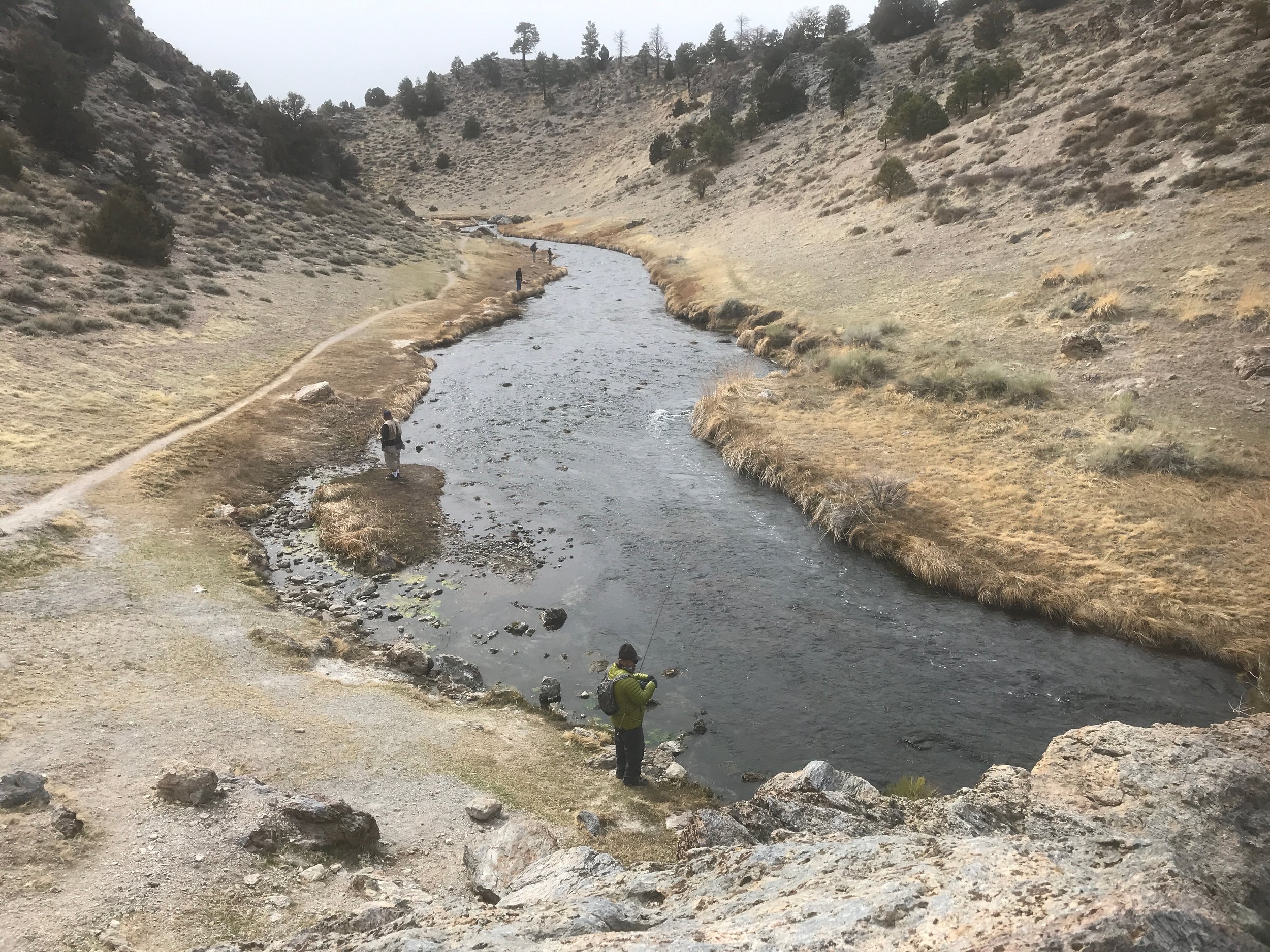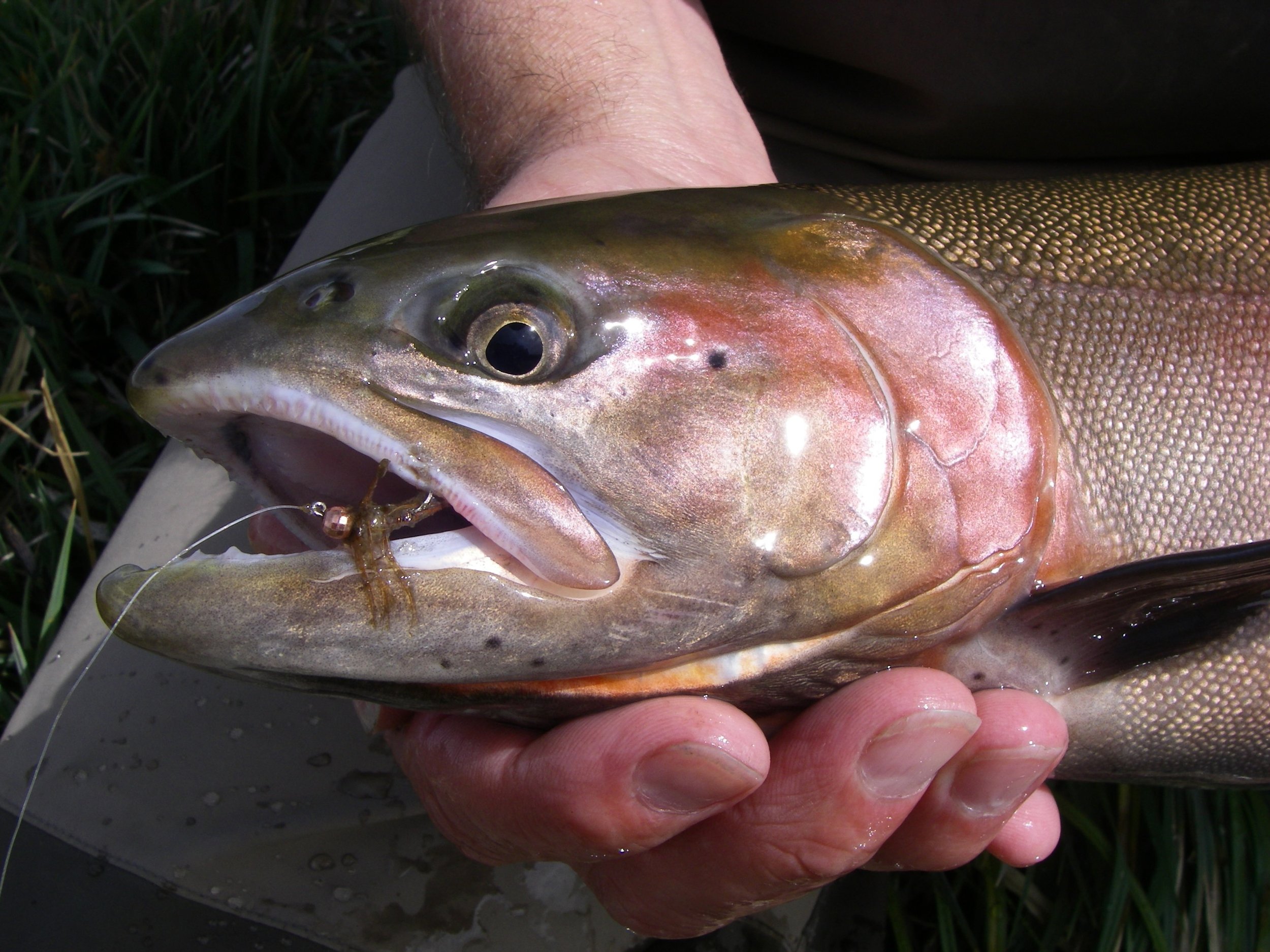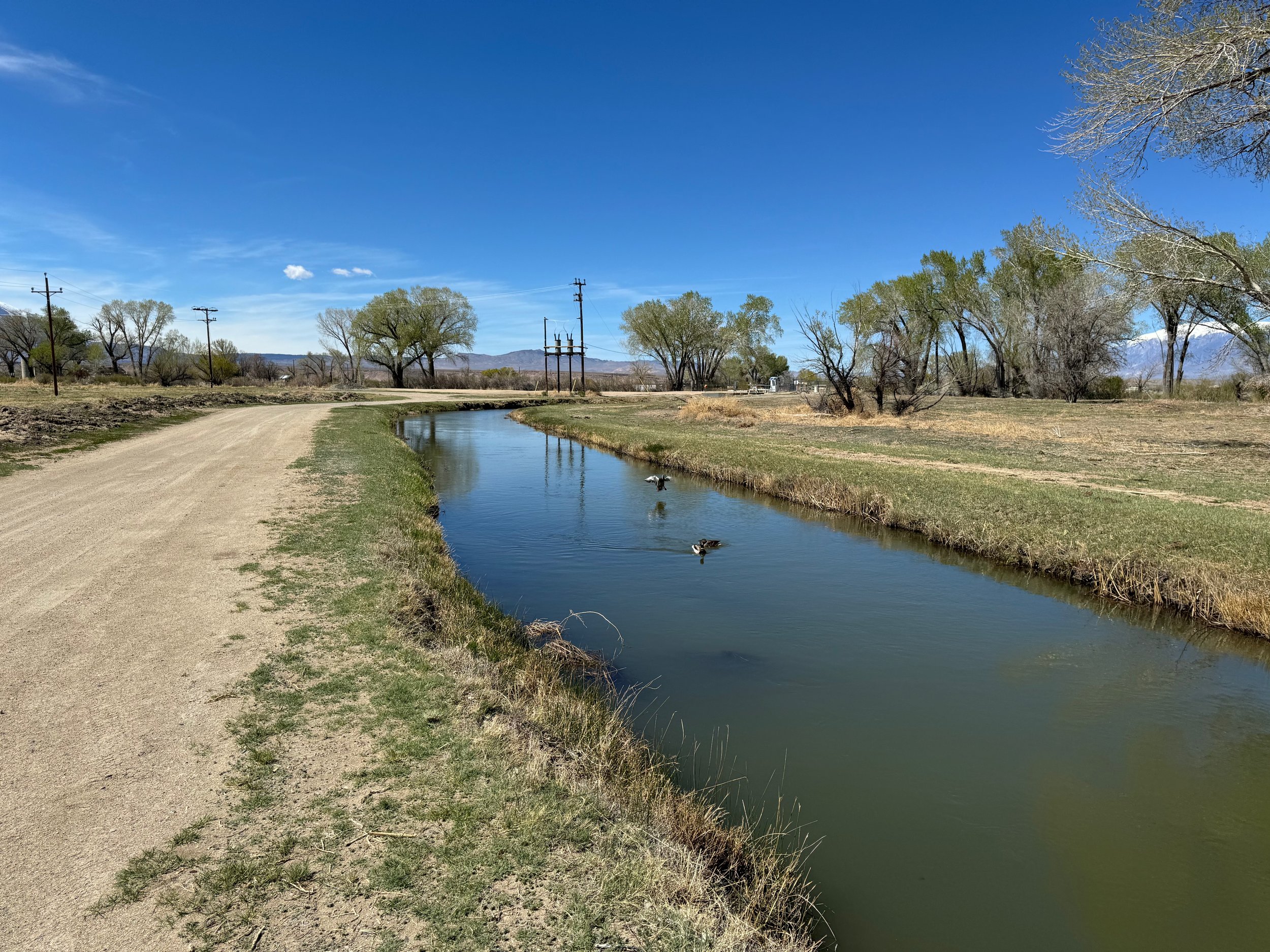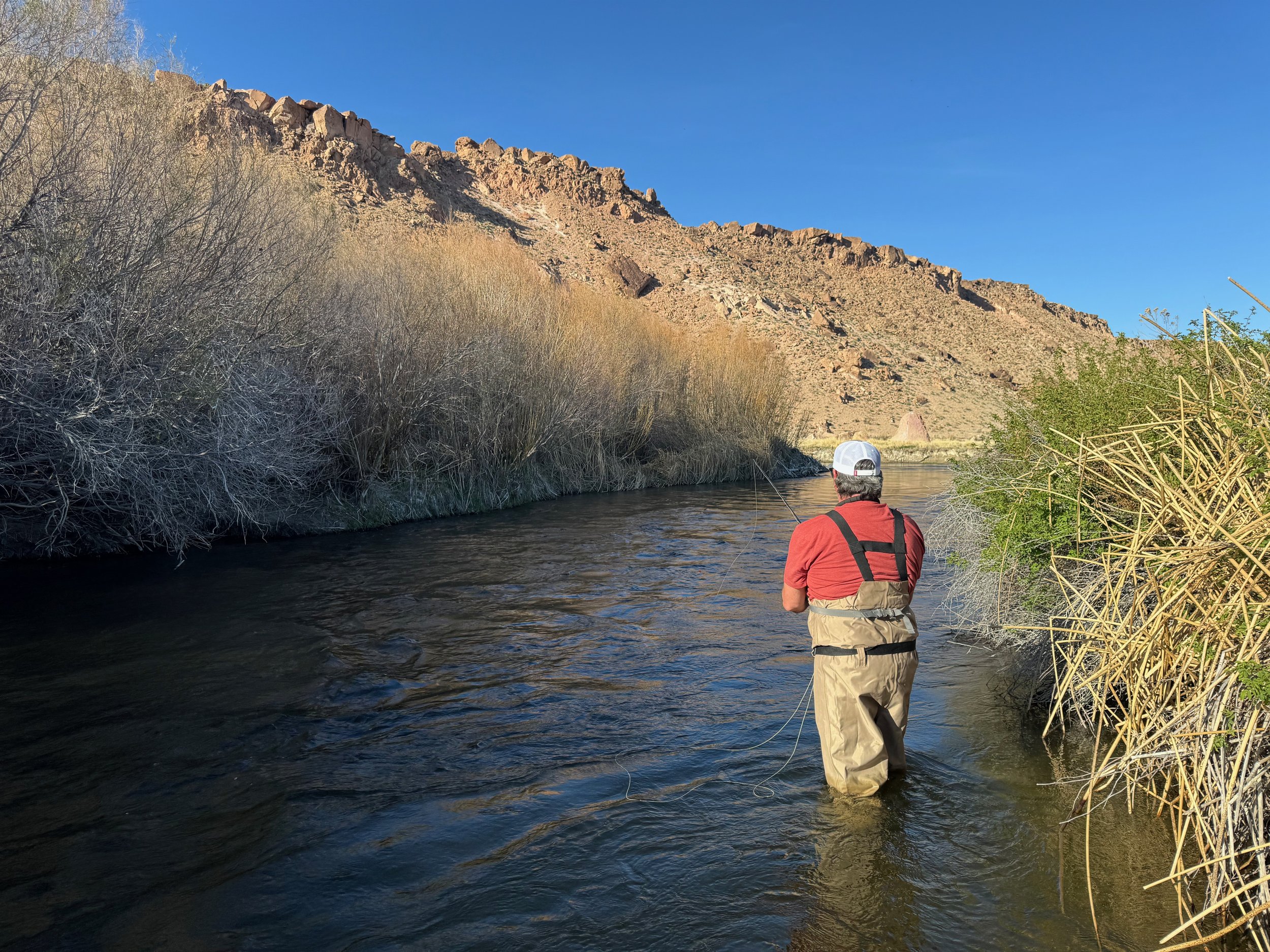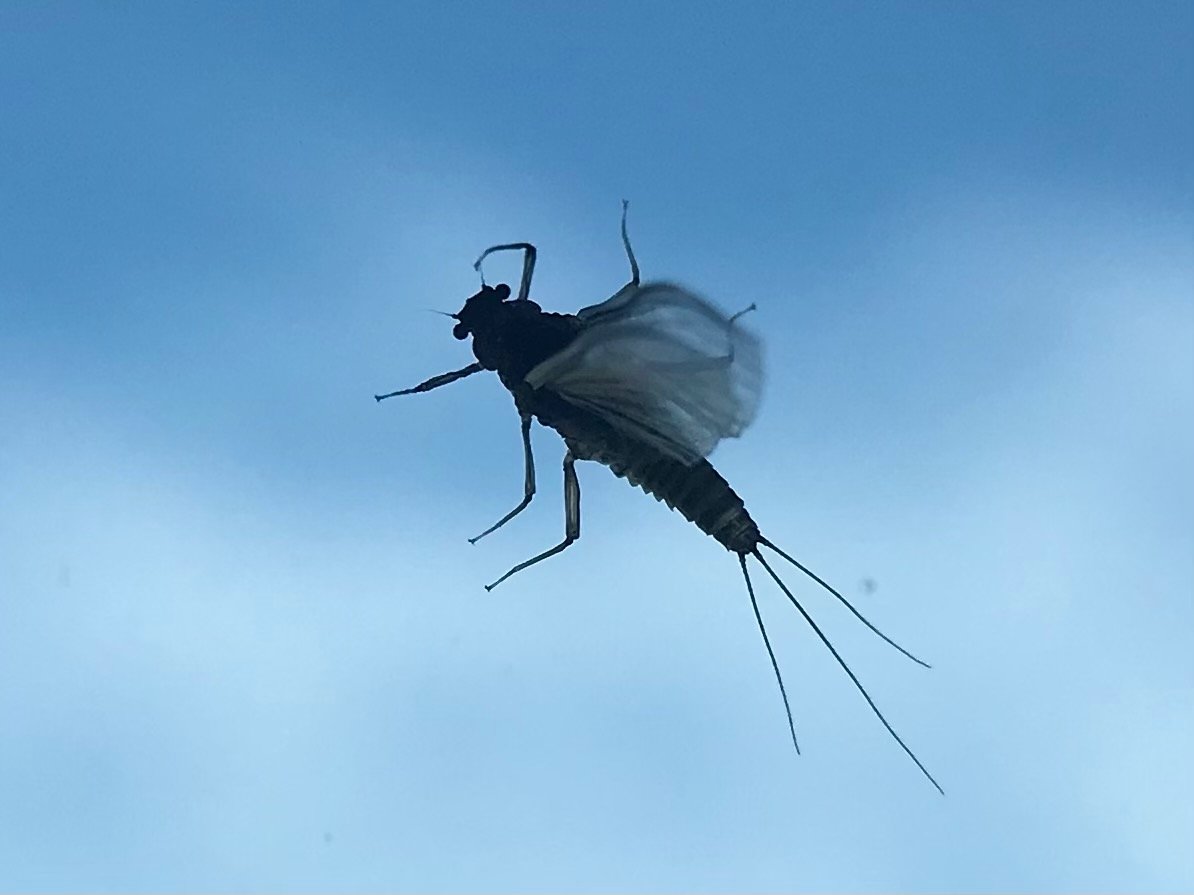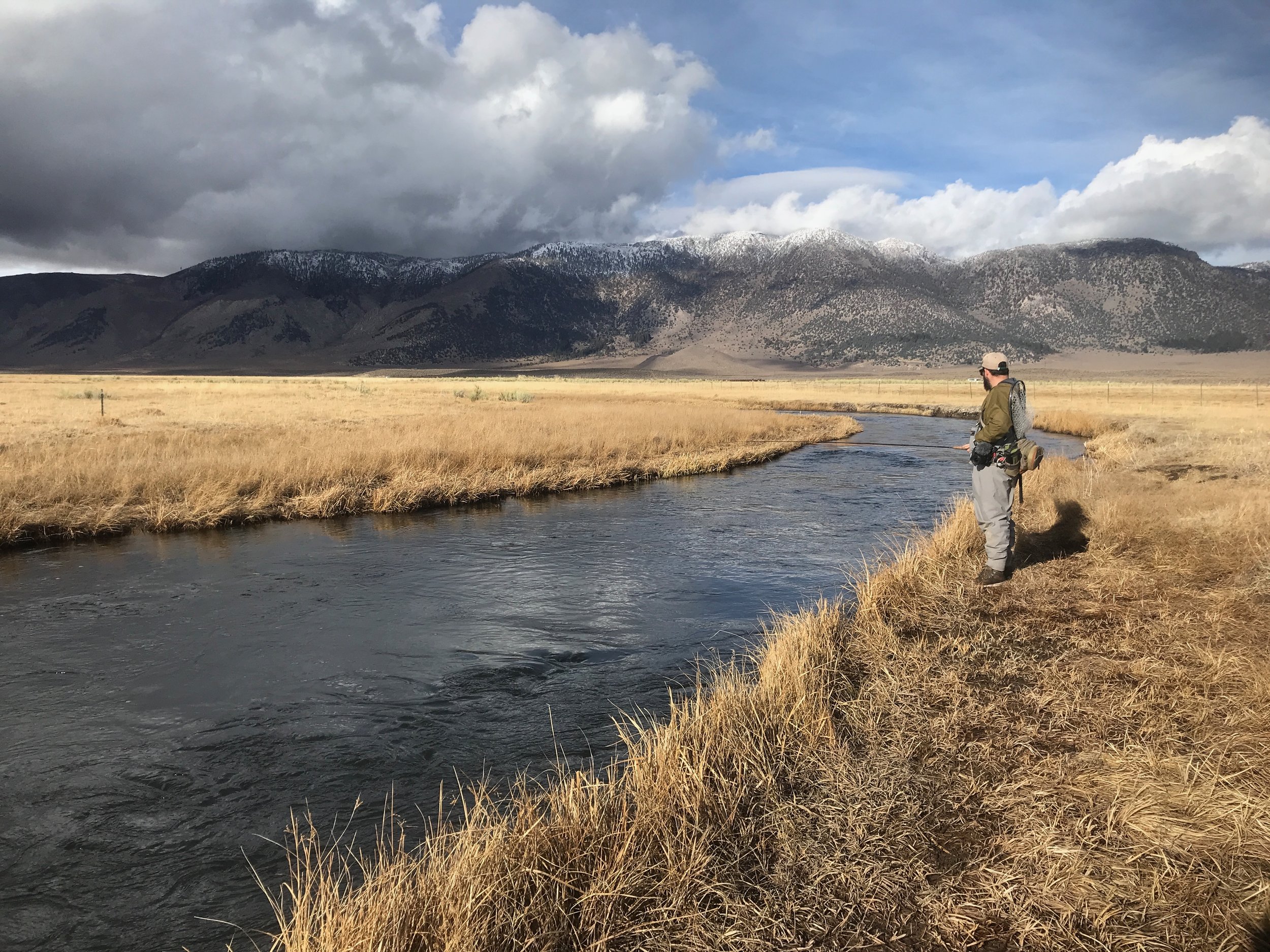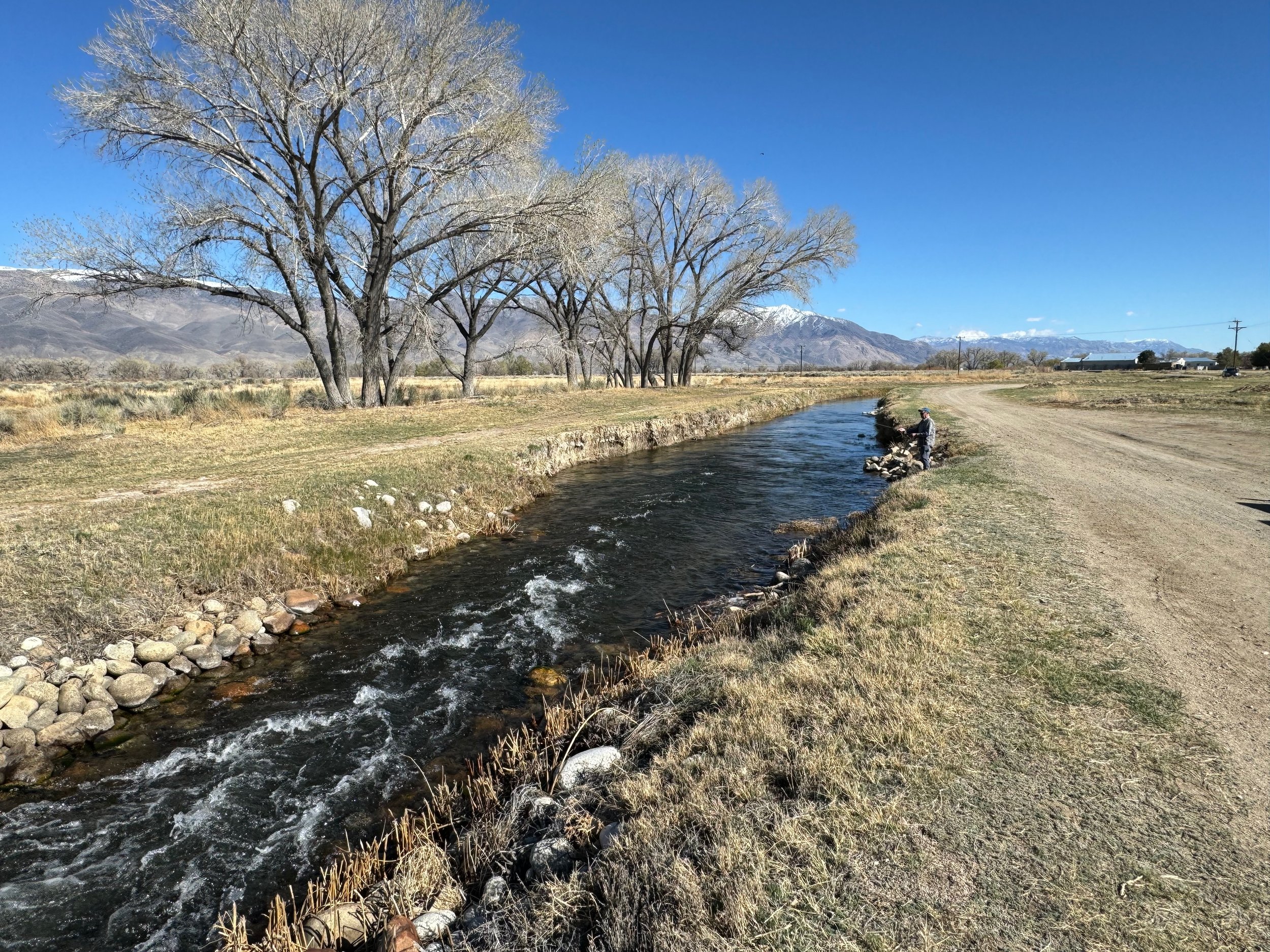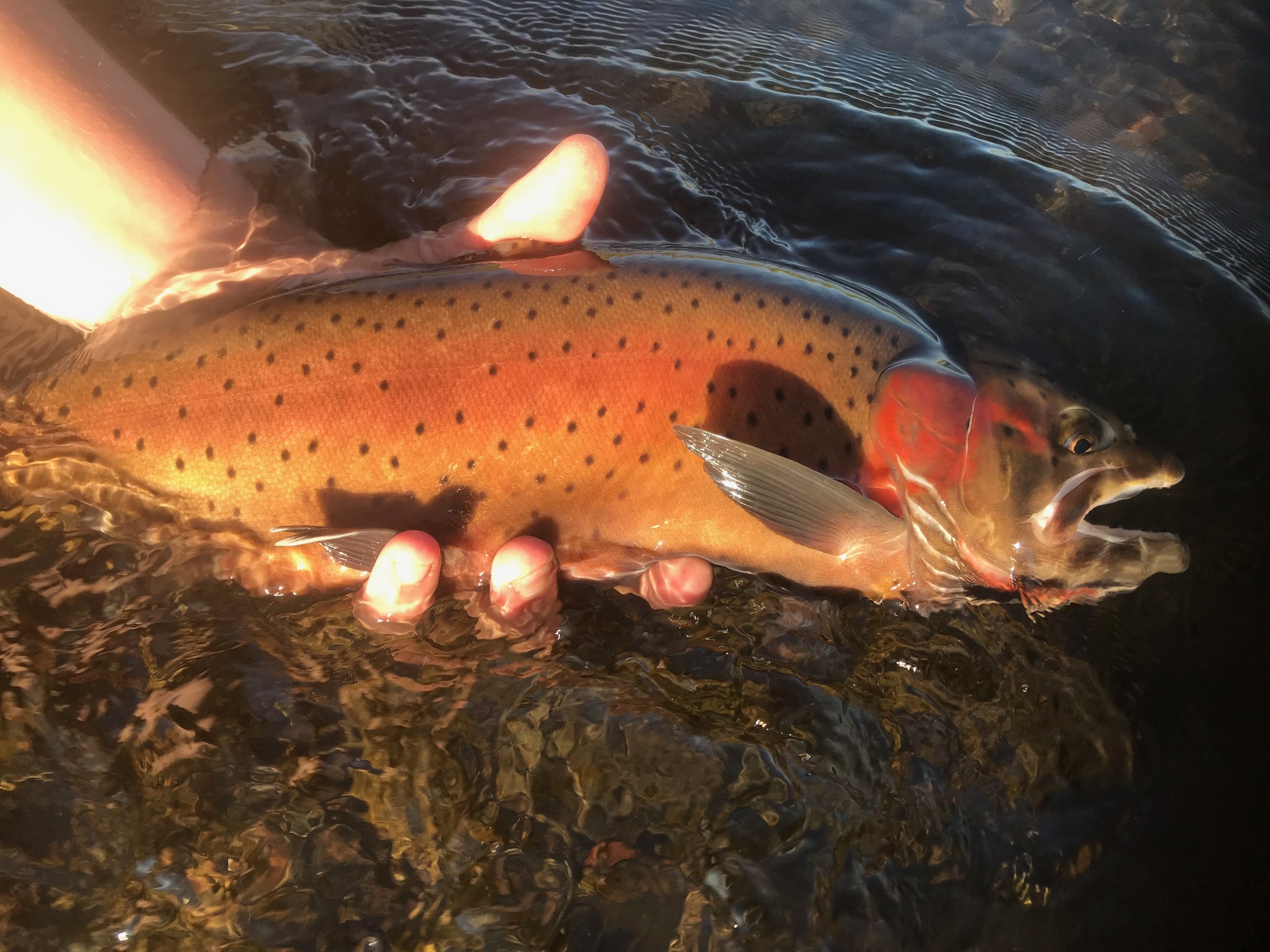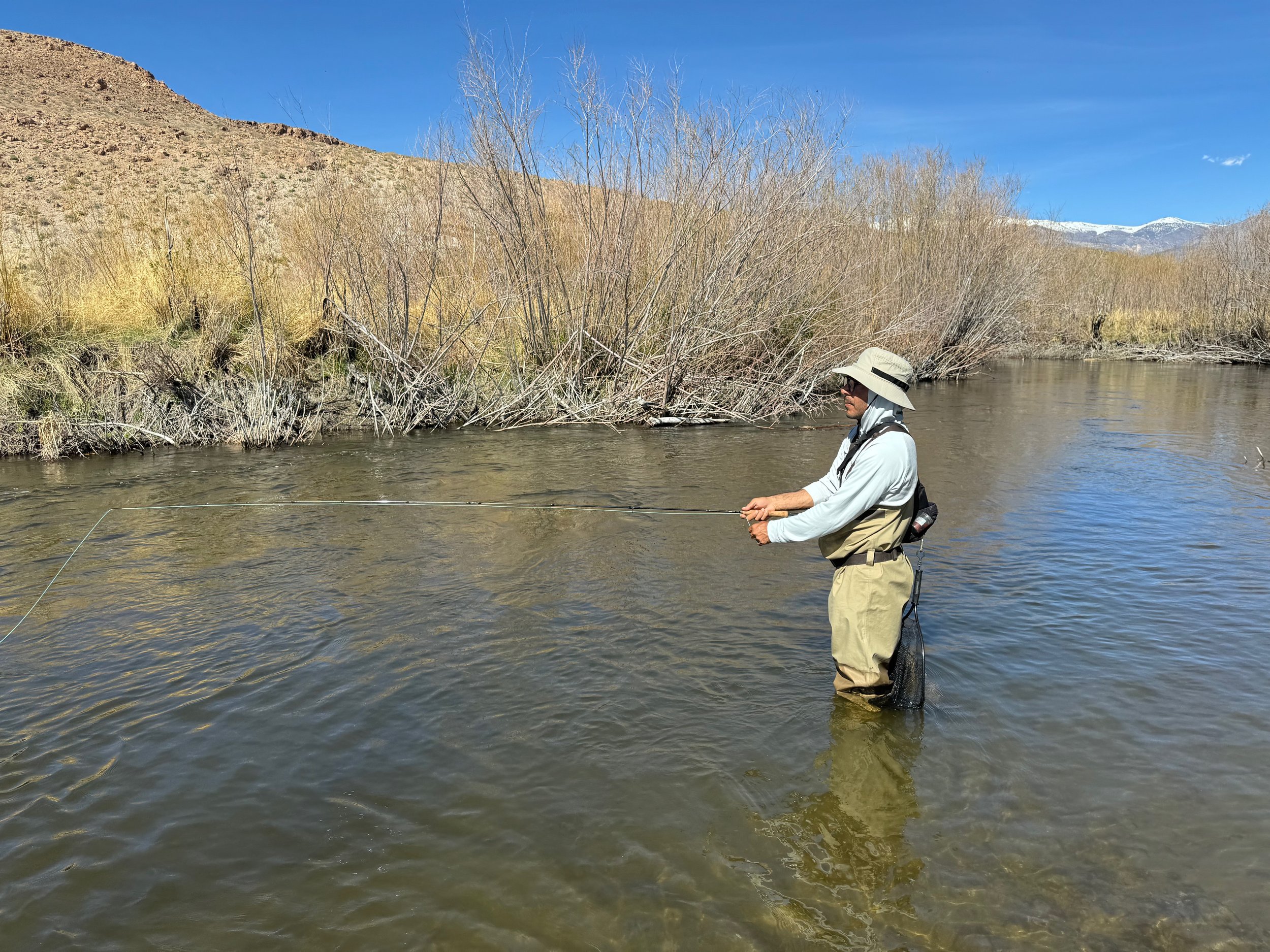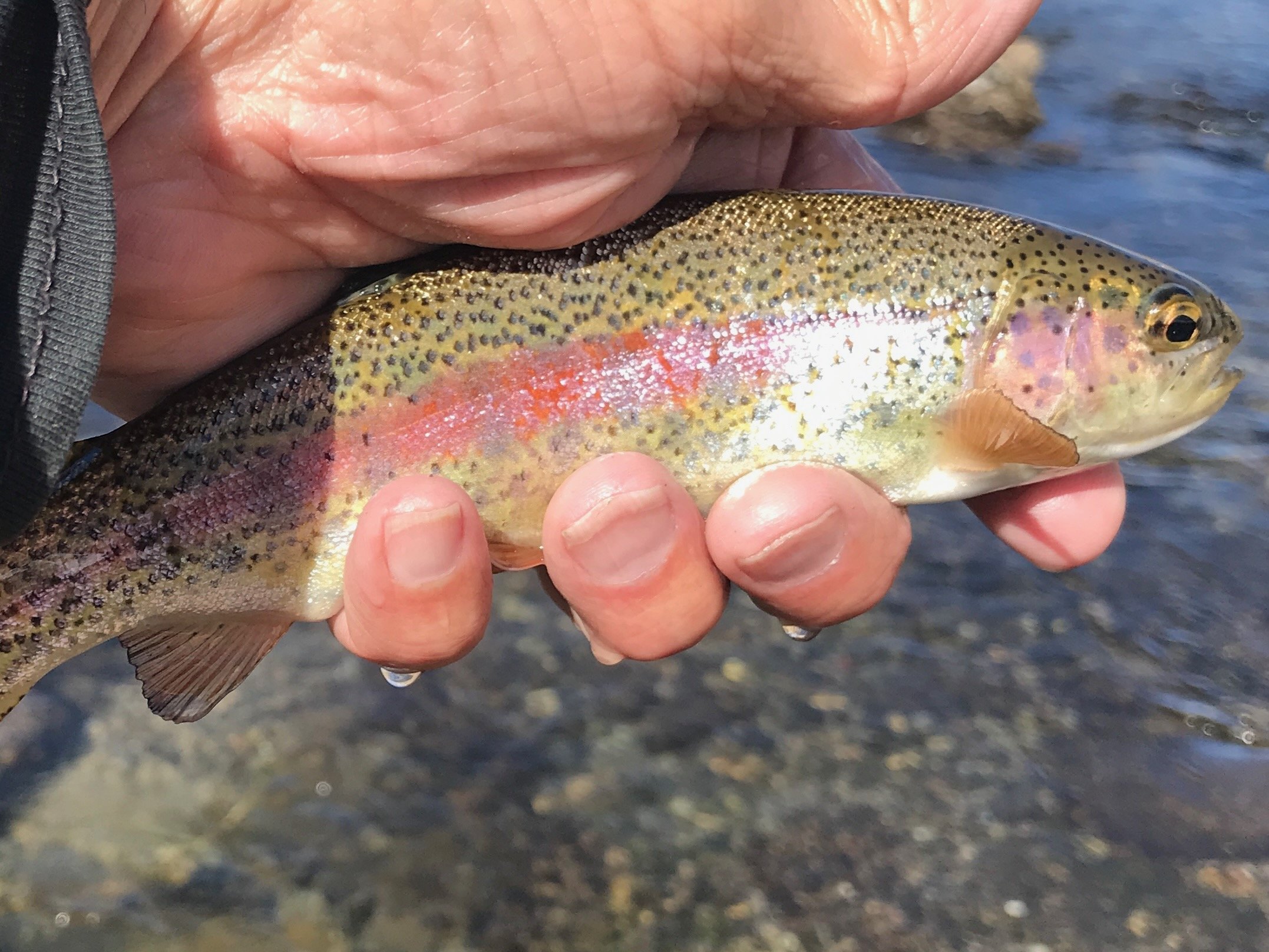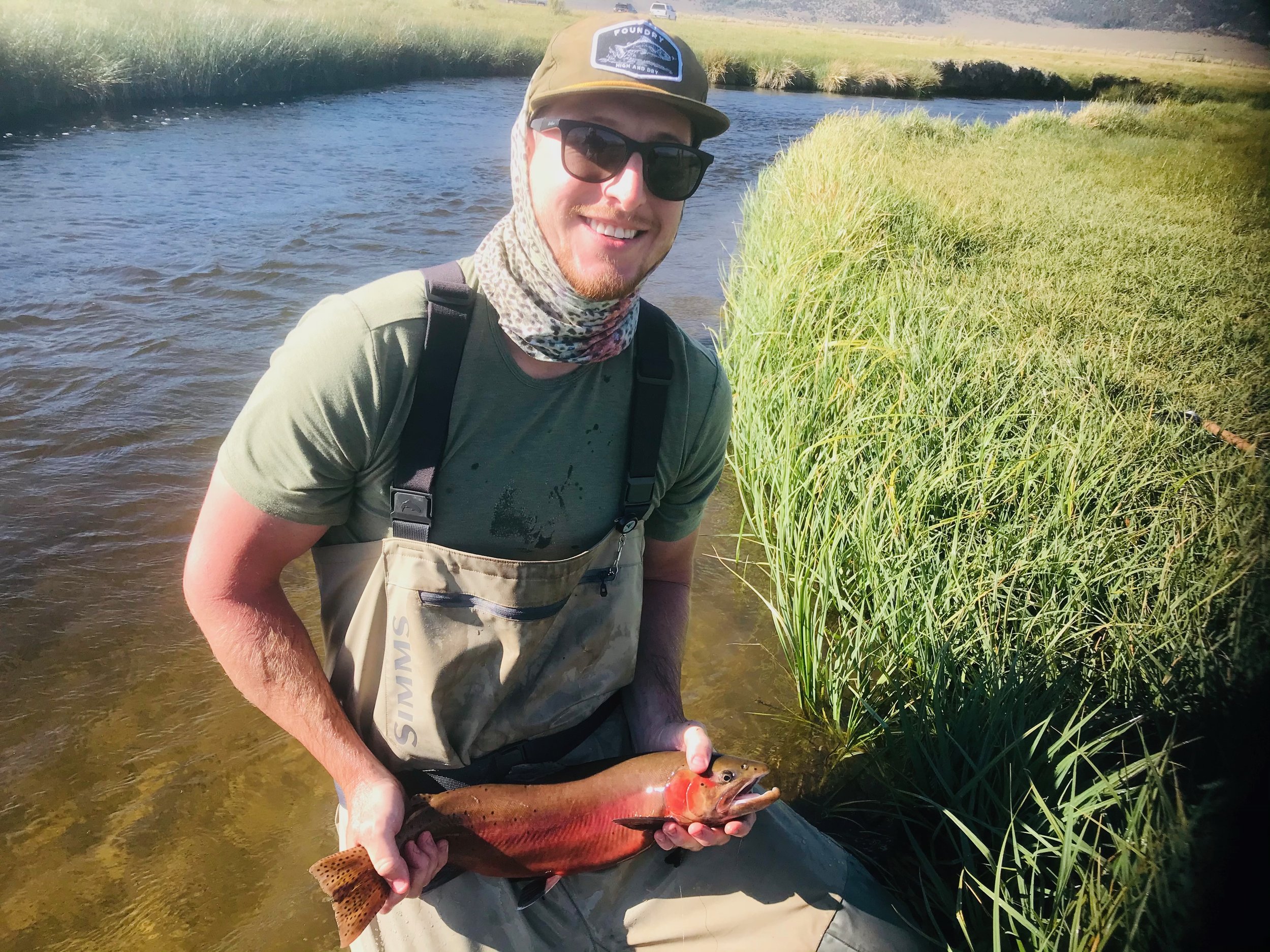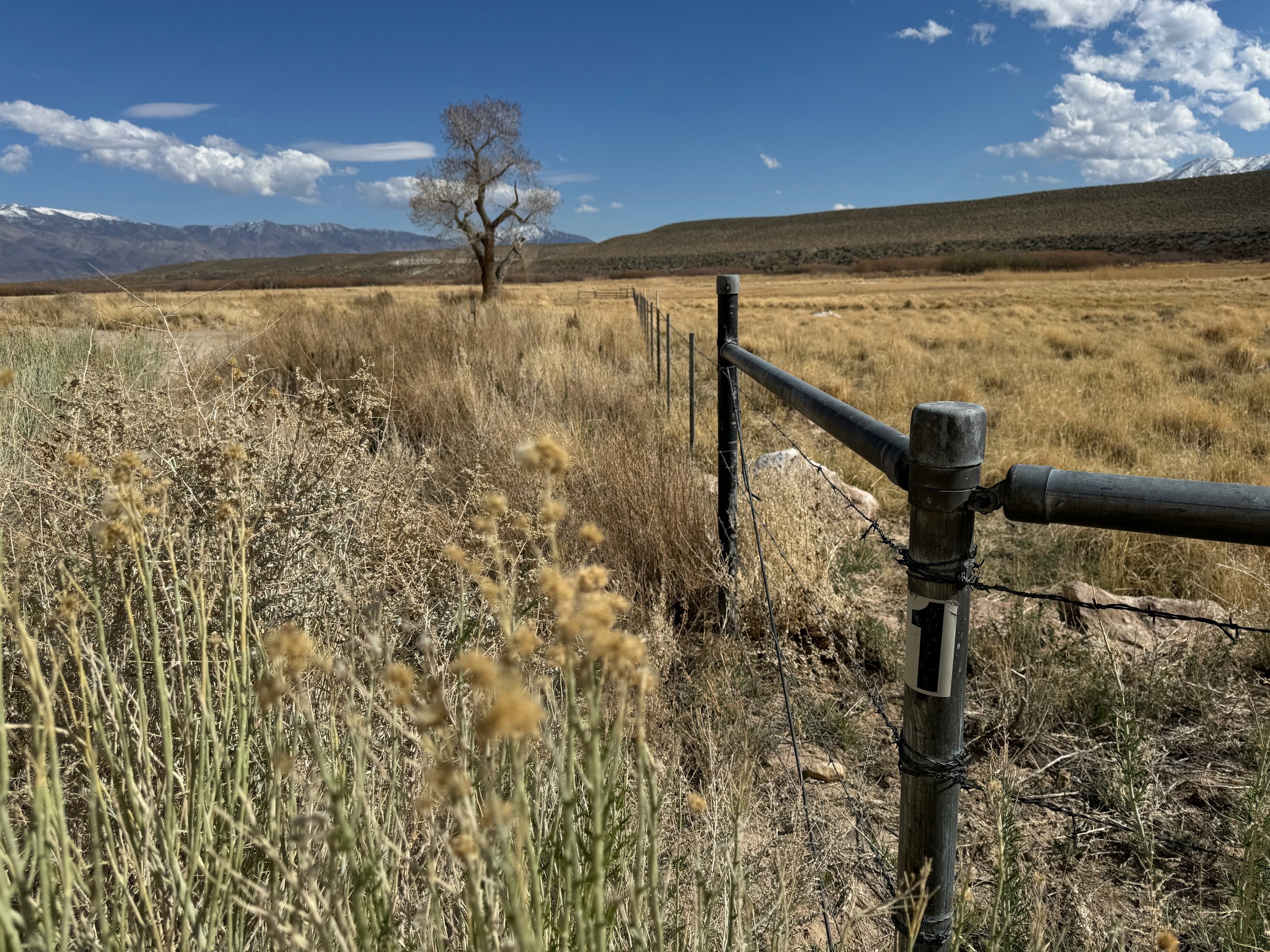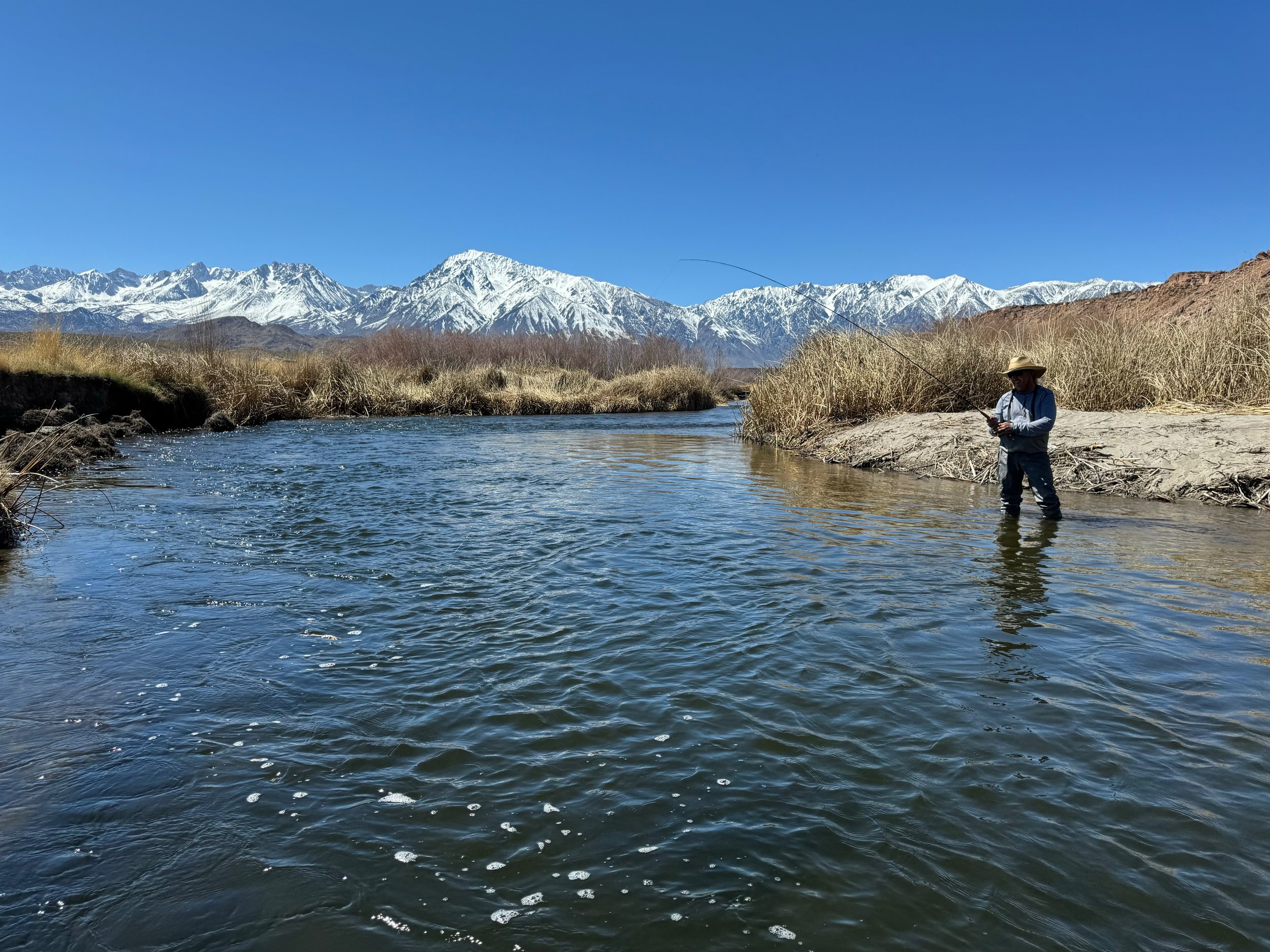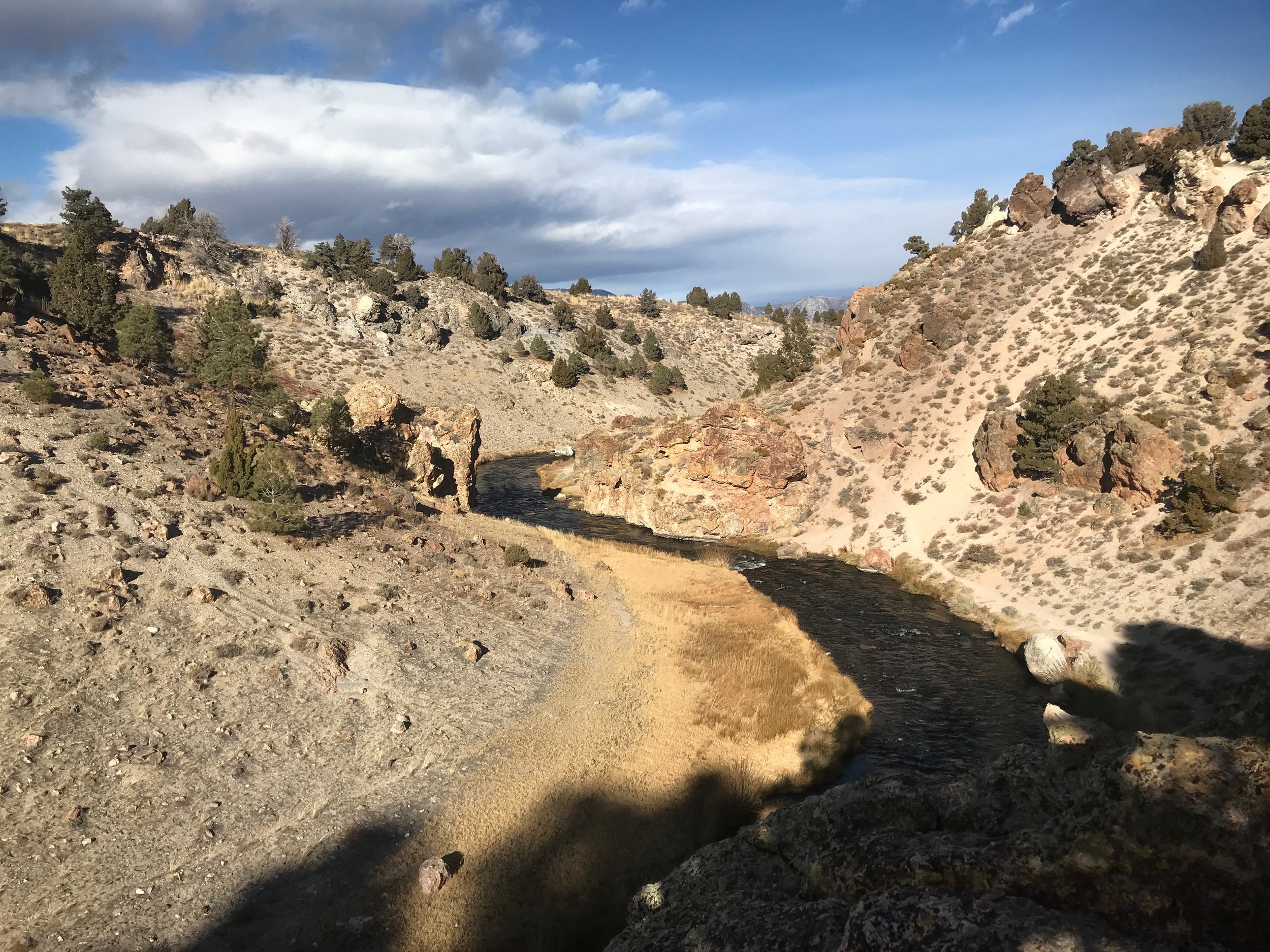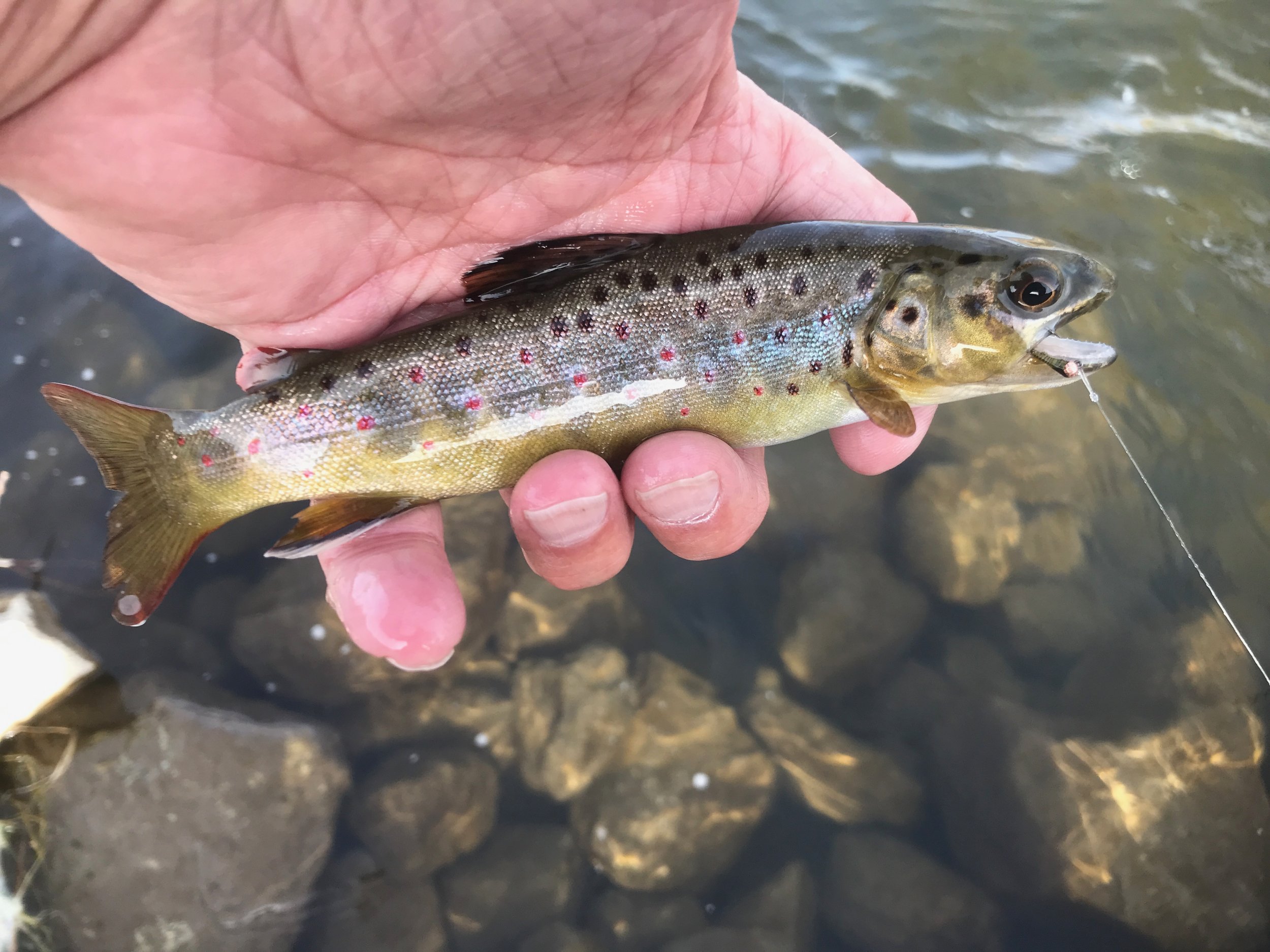I’m hoping that after a couple weeks of heavy winds almost every day the wind is finally settling down. We always have wind in the Eastern Sierra and fly fishers need to learn how to cast in the wind. Trout fishing is going good with most waters fly fishing good. Hatches of mayflies, midges and caddis are keeping the trout feeding. Spring spawning is just about over in most waters for rainbows and cutthroats. Brown trout and brook trout will be spawning this Fall. Blue gill and bass fishing is just starting to get going. Been seeing some nice bass being caught in the local ponds, canals and the lower Owens River. June is a great month to be fly fishing in the Eastern Sierra and Sierra Bright Dot is ready to guide you on one of the Eastern Sierra Fly Fishing waters.
As the weather warms up it time to wet wade in Eastern Sierra waters like the upper Owens River.
Lower Owens River
Wild Trout Section:
Flows are high and this is the last report for the lower Owens River until the flows recede or the caddis hatch bring trout to the surface during the summer months.
Lower Owens River flows are up to 575 CFS which is too high to safely wade and fly fish the spots that are only accessible by wading.
Owens River Gorge
Middle Gorge Power Plant:
Dry and dropper fly fishing continues to produce wild brown trout in the Owens River Gorge. Most fly fishers quit fishing here in the summer months due to the heat, rattlesnake activity and big stands of stinging nettles along the riparian zone. For the dry fly elk hair caddis and Adams parachutes are producing trout on the surface. Most of the trout are taking nymphs under the dry fly like size 18 bead head flash back pheasant tail nymphs and bead head flash back gold ribbed hare’s ears. Perdigons work really well in the gorge.
Sierra Bright Dot Fly Fishing guide Richard Lancaster fishing a tenkara rod in the Owens River Gorge with Tenkara Tanuki owner Luong Tam.
East Walker River
Below Bridgeport Reservoir:
Perfect conditions for nymphing and dry fly fishing will be found by fly fishers exploring the waters of the East Walker River on the California side. Nymphing with an indicator rig or a Euro rig with bead head flash back pheasant tail nymphs, bead head flash back gold ribbed hare’s ears, tiger midges, zebra midges, cream caddis nymphs and peeking caddis is producing rainbow and brown trout to 18 inches. There is a good mid-morning hatch of caddis and blue wing olive mayflies which the trout have been coming to the surface to feed on. Dry fly anglers fishing with elk hair caddis, X-caddis, blue wing olive parachutes and Adams parachutes are enjoying rare dry fly action on the East Walker River.
Shannon Chastain with a rainbow trout she fooled with a pheasant tail nymph fished under an indicator on the miracle mile section of the East Walker River.
Hot Creek
Interpretive Site:
With the warmer weather the flows are increasing and are dirty from the runoff entering the creek from Mammoth Creek. On the right days you can catch the trout on a dry fly, but nymphing continues to be the most productive method of fly fishing Hot Creek. Euro nymphing and indicator nymphing are producing the trout. With the increased flows a split shot is needed to get the nymphs bouncing on the substrate. This addition in weight is causing the dry fly in a dry dropper rig to be pulled off the surface and sinking. Tiger midges, zebra midges, bead head flash back pheasant tail nymphs, bead head flash back gold ribbed hare’s ears and hot spot pheasant tail nymphs are producing trout in the eight to 14 inch size range.
Nymphing with an indicator in Hot Creek Canyon and a bead head flash back pheasant tail nymph is a productive method that is producing eight to 14 inch wild browns and rainbow trout.
Hot Creek
Canyon Section:
As the month of May comes to an end I hope so does the no-see-ums. They are one insect that eats me up. With the increased flows from spring runoff a dry and dropper rig is no longer effective. A Euro rig or an indicator rig is what is working for nymphing. Set the indicator at three feet above the bottom fly and adjust it for the deeper holes if you need to. A size one split shot has been enough weight to keep the nymphs bouncing on the substrate. It’s about time for the pale morning duns and the little yellow stones to start hatching. These two insects are the biggest insects that hatch in Hot Creek. I fish both of these pattens in size 14 and 16, much bigger than my normal size 18 to 22 fly patterns. For flies fish with a stoner nymph or cooper John in size 14 and a bead head flash back gold ribbed hare’s ear ins size 14 or 16.
Hilton Bay is getting a lot boats and float tubers working midges in the bay at 20 feet over the mud beds.
Crowley Lake
North Landing:
Access is still restricted due to the high lake levels. Alligator Point and Crooked Creek arm are the only two shore access points other than going through the gate at South Marina. Float tubers, Kayakers and boats are finding fish all over the lake. Best fishing has been in waters under 20 feet deep. The key to success in fly fishing Crowley Lake is suspending your midge imitations off the substrate. In the mornings working your flies three to six inches of the bottom will produce trout. Once the sun starts to climb up and light up the lake the midges start migrating up the water column. This is when fly fishers need to adjust their flies depth off the substrate. Some days the trout are feeding as much as four to five feet off the substrate of the lake. As the fish feed higher in water column the amount of penetrating light changes the color of the nymphs. Changing midge colors latter in the morning is another way to improve the fly fishers catch rate. To imitate the midges use tiger midges, zebra midges, gray midges, albino Barron’s and blood midges in size 16 and 18. Jansen’s damsel fly nymph in a size 10 and callibaetis nymphs in size 14 are two fly patterns that produce trout when the trout are not feeding on the midges.
The last cutthroat of the 2024 season was caught on a beginners guide trip on the upper Owens River over Memorial day weekend.
Upper Owens River
Above Benton Crossing Bridge:
It was a great cutthroat season on the upper Owens River. The run is pretty much over for the year. This is a very short run starting in early May and ending by Memorial day or 1st of June. The best time to fly fish for this run is from the May 10th to May 20th. This is when the fish are fresh in the river coming up from the lake and are just starting to spawn. Now is the time to consider a trip up to the upper Owens River for next years cutthroat spawning run. Sierra Bright Dot Fly Fishing Guide Service is taking bookings for next year. There is a good population of eight to 12 inch juvenile brown and rainbow trout willing to take insect imitations. On the surface fish dry flies like elk hair caddis, Adams parachutes, blue wing olive parachutes and pale morning dun parachutes in size 16. For nymphing use size 14 or 16 bead head flash back gold ribbed hare’s ears, size 18 bead head flash back pheasant tail nymphs, size 18 tiger midges and zebra midges to catch the juvenile trout. On an indicator rig use a size one split shot and have the indicator about six feet above the fly which is about 1 ½ to 2 times the average depth of water.
The field next to Bishop Creek Canal is a great place to teach fly casting to beginners like Hayden Grant before he learned how to fish a nymph under an indicator.
Bishop Creek Canal
Behind Bishop Veterinary Hospital:
The Owens Valley is warming up quick. Day time temperatures are already into the 90’s. This is not effecting the trout as the water temperatures have been hovering around a perfect trout temperature of 55 degrees. Not seeing a lot of surface feeding trout yet. The trout are taking nymphs like tiger midges, zebra midges, bead head flash back pheasant tail nymphs, bead head flash back gold ribbed hare’s ears, green/gold wire Prince nymphs and stoner nymphs. Fish these flies on the sandy bottom runs of the creek between the weed beds.


